The Quest Towards Superhydrophobic Cellulose and Bacterial Cellulose Membranes and Their Perspective Applications
Abstract
1. Introduction
2. Functionalization Methods for Cellulose and Bacterial Cellulose Membranes
2.1. Cellulose and Bacterial Cellulose Properties and Production Methods
2.2. Categorization of Functionalization Methods and Applications of Interest for Cellulose and Bacterial Cellulose Membranes
2.3. In Situ Functionalization Methods for Cellulose and Bacterial Cellulose Membranes
2.3.1. In Situ Chemical Functionalization Methods
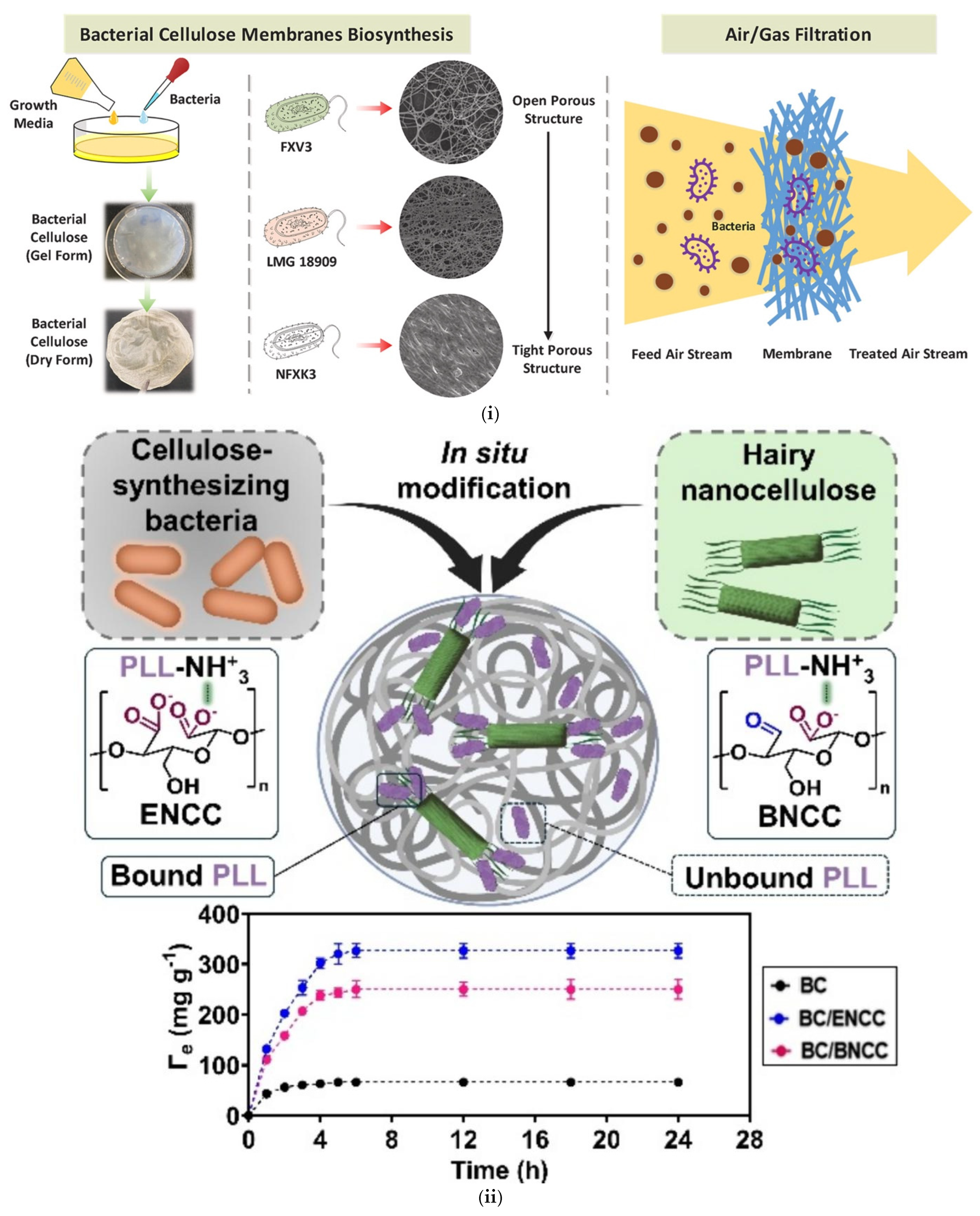
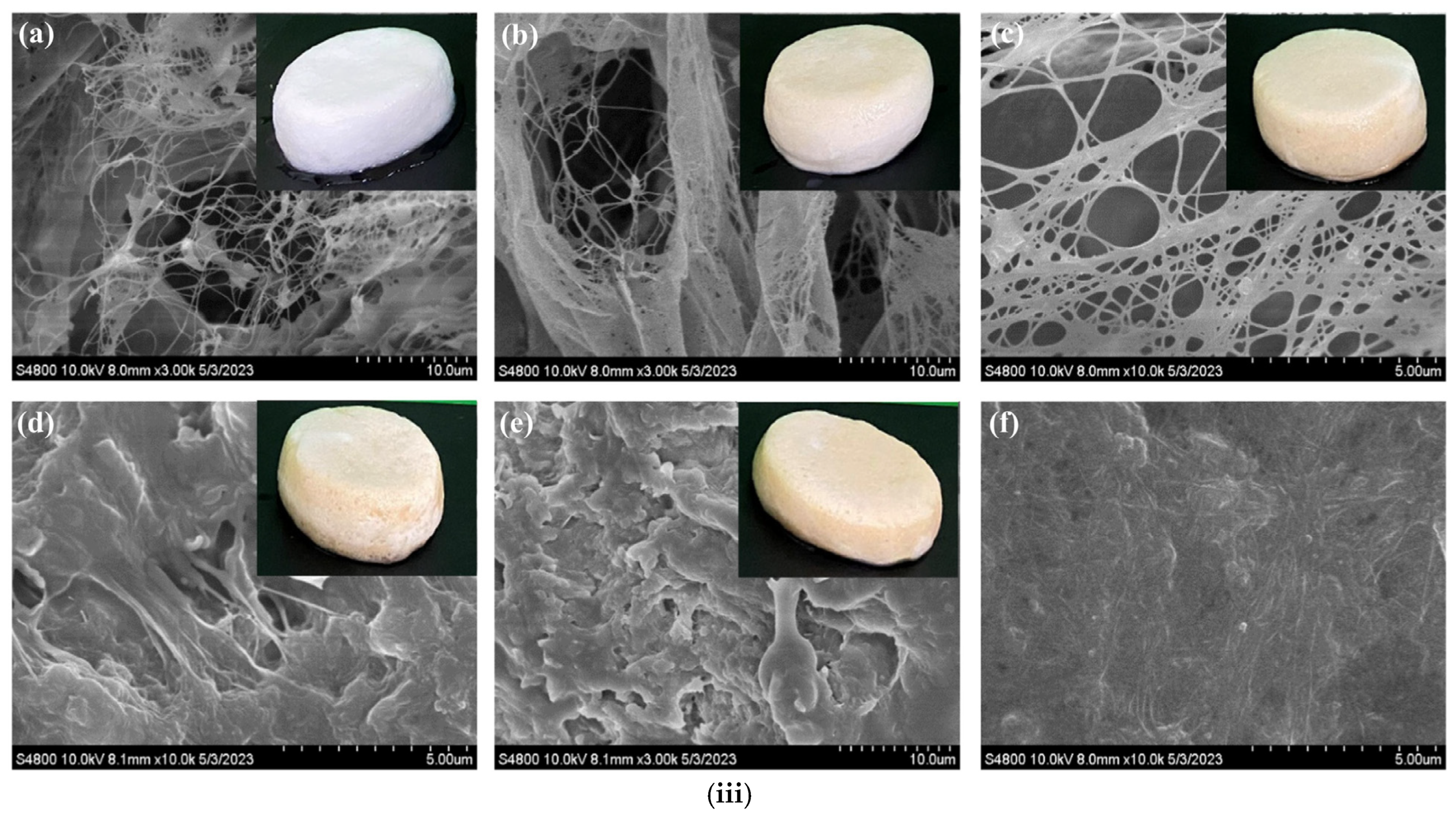
2.3.2. In Situ, Pattern Transfer Methods
2.4. Εx-Situ Functionalization Methods for Bacterial Cellulose and Cellulose
2.4.1. Ex Situ, Chemical Modification and Synthesis Methods
2.4.2. Plasma Based Functionalization Methods
2.4.3. Electrospinning
2.4.4. Other Ex Situ Functionalization Methods
2.4.5. Laser and Electron Beam Patterning
2.4.6. Ex Situ Imprinting Methods
3. Current and Emerging Applications of Functionalized BC Membranes
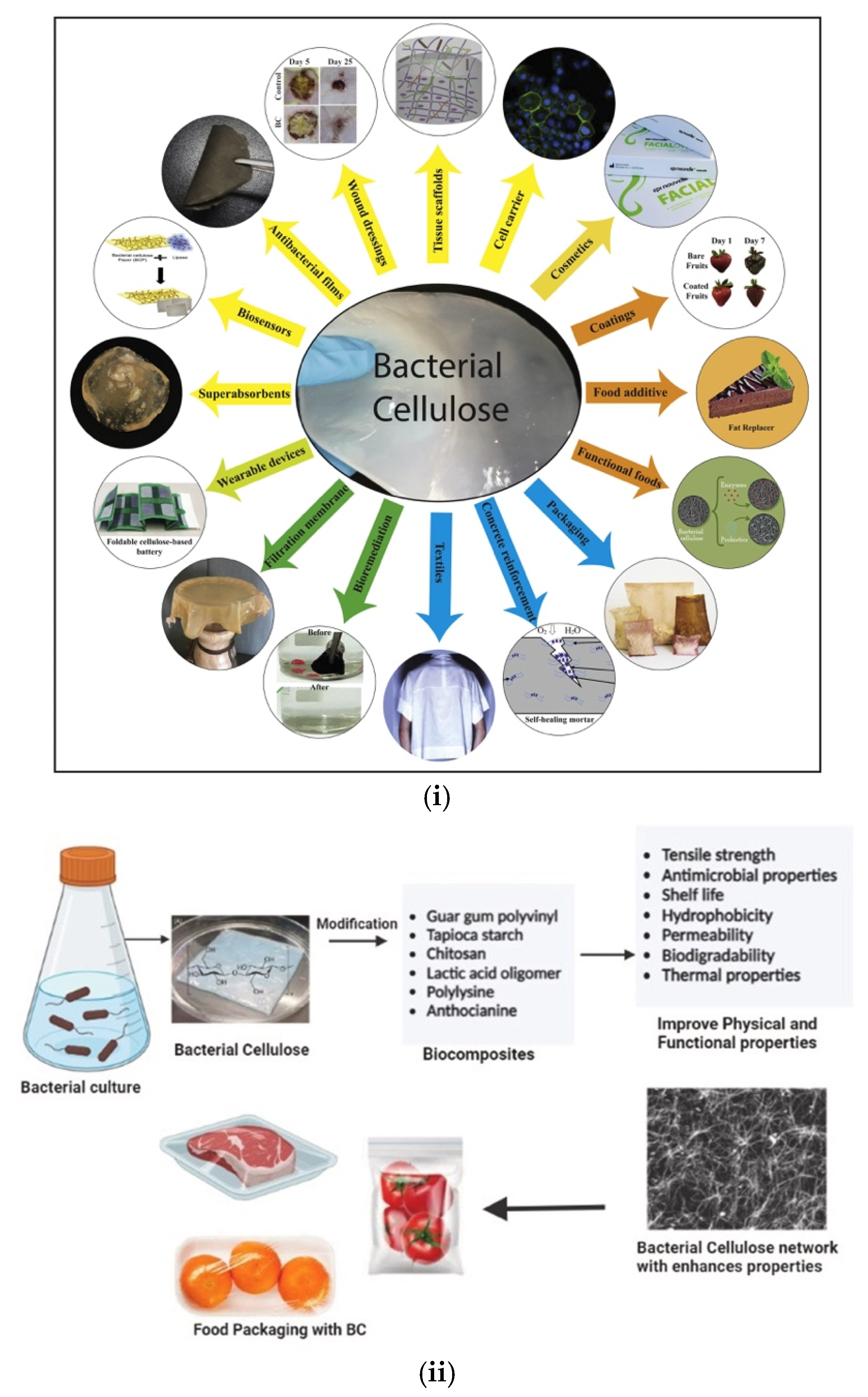
3.1. Wetting Control of Functionalized Bacterial Cellulose and Cellulose for Separation Applications
3.2. Antibacterial Action of Functionalized Bacterial Cellulose and Cellulose for Food Packaging and Wound Healing Applications
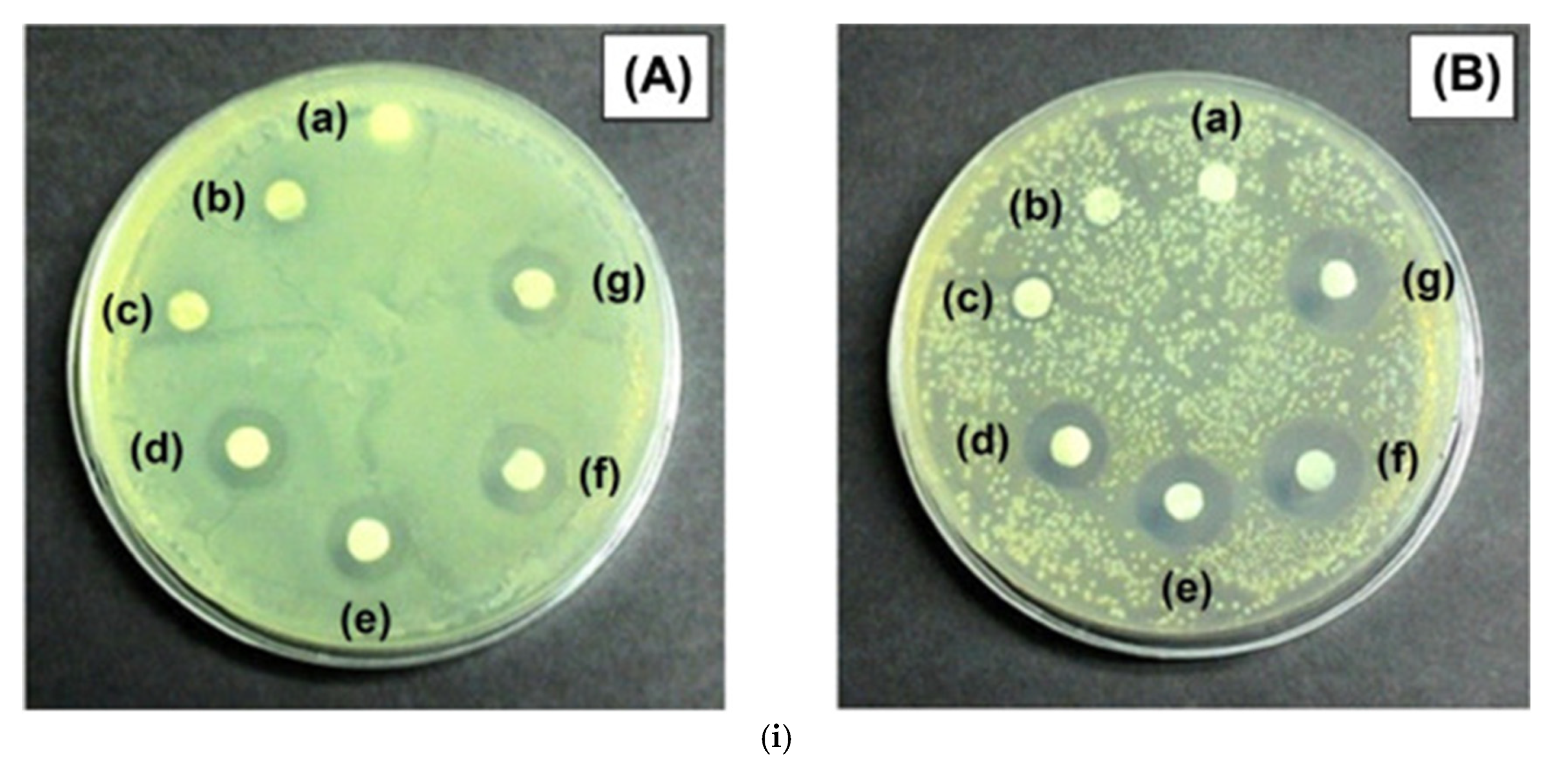
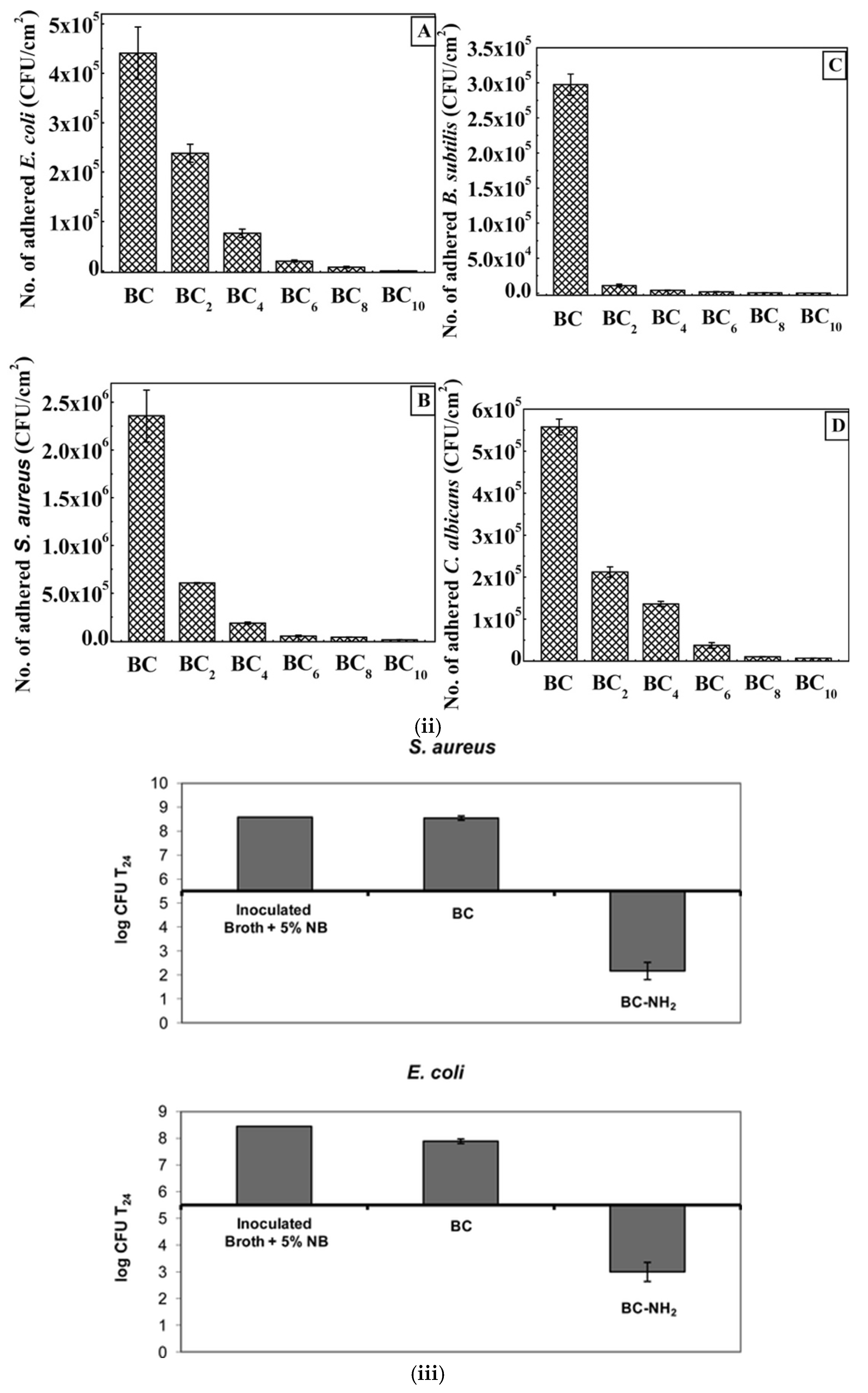
4. Challenges and Future Perspectives
Author Contributions
Funding
Conflicts of Interest
References
- Hsissou, R.; Seghiri, R.; Benzekri, Z.; Hilali, M.; Rafik, M.; Elharfi, A. Polymer composite materials: A comprehensive review. Compos. Struct. 2021, 262, 113640. [Google Scholar] [CrossRef]
- Dragatogiannis, D.A.; Koumoulos, E.; Ellinas, K.; Tserepi, A.; Gogolides, E.; Charitidis, C.A. Nanoscale Mechanical and Tribological Properties of Plasma Nanotextured COP Surfaces with Hydrophobic Coatings. Plasma Process. Polym. 2015, 12, 1271–1283. [Google Scholar] [CrossRef]
- Ellinas, K.; Gogolides, E. Ultra-low friction, superhydrophobic, plasma micro-nanotextured fluorinated ethylene propylene (FEP) surfaces. Micro Nano Eng. 2022, 14, 100104. [Google Scholar] [CrossRef]
- Ioannou, D.; Shah, P.; Ellinas, K.; Kappl, M.; Sapalidis, A.; Butt, H.J.; Gogolides, E. Antifouling Plasma-Treated Membranes with Stable Superhydrophobic Properties for Membrane Distillation. ACS Appl. Polym. Mater. 2023, 5, 9785–9795. [Google Scholar] [CrossRef]
- Tajeddin, B.; Arabkhedri, M. Polymers and food packaging. In Polymer Science and Innovative Applications: Materials, Techniques, and Future Developments; Elesvier: Amsterdam, The Netherlands, 2020; pp. 525–543. [Google Scholar] [CrossRef]
- Wojnowska-Baryła, I.; Bernat, K.; Zaborowska, M. Plastic Waste Degradation in Landfill Conditions: The Problem with Microplastics, and Their Direct and Indirect Environmental Effects. Int. J. Environ. Res. Public Health 2022, 19, 13223. [Google Scholar] [CrossRef] [PubMed]
- Zhou, C.; Fang, W.; Xu, W.; Cao, A.; Wang, R. Characteristics and the recovery potential of plastic wastes obtained from landfill mining. J. Clean. Prod. 2014, 80, 80–86. [Google Scholar] [CrossRef]
- Samir, A.; Ashour, F.H.; Hakim, A.A.A.; Bassyouni, M. Recent advances in biodegradable polymers for sustainable applications. Npj. Mater. Degrad. 2022, 6, 68. [Google Scholar] [CrossRef]
- Urbina, L.; Corcuera, M.Á.; Gabilondo, N.; Eceiza, A.; Retegi, A. A review of bacterial cellulose: Sustainable production from agricultural waste and applications in various fields. Cellulose 2021, 28, 8229–8253. [Google Scholar] [CrossRef]
- Rao, M.G.; Bharathi, P.; Akila, R.M. A Comprehensive Review on Biopolymers. Sci. Revs. Chem. Commun. 2014, 4, 61–68. [Google Scholar]
- Hernández, N.; Williams, R.C.; Cochran, E.W. The battle for the “green” polymer. Different approaches for biopolymer synthesis: Bioadvantaged vs. Bioreplacement. Org. Biomol. Chem. 2014, 12, 2834–2849. [Google Scholar] [CrossRef]
- Suarato, G.; Bertorelli, R.; Athanassiou, A. Borrowing From Nature: Biopolymers and Biocomposites as Smart Wound Care Materials. Front. Bioeng. Biotechnol. 2018, 6, 137. [Google Scholar] [CrossRef]
- Yadav, C.; Saini, A.; Zhang, W.; You, X.; Chauhan, I.; Mohanty, P.; Li, X. Plant-based nanocellulose: A review of routine and recent preparation methods with current progress in its applications as rheology modifier and 3D bioprinting. Int. J. Biol. Macromol. 2021, 166, 1586–1616. [Google Scholar] [CrossRef]
- Boateng, J.; Catanzano, O. Advanced therapeutic dressings for effective wound healing—A review. J. Pharm. Sci. 2015, 104, 3653–3680. [Google Scholar] [CrossRef] [PubMed]
- Cui, C.; Gao, L.; Dai, L.; Ji, N.; Qin, Y.; Shi, R.; Qiao, Y.; Xiong, L.; Sun, Q. Hydrophobic Biopolymer-Based Films: Strategies, Properties, and Food Applications. Food Eng. Rev. 2023, 15, 360–379. [Google Scholar] [CrossRef]
- Barthlott, W.; Neinhuis, C. Purity of the sacred lotus, or escape from contamination in biological surfaces. Planta 1997, 202, 1–8. [Google Scholar] [CrossRef]
- Ivanova, E.P.; Hasan, J.; Webb, H.K.; Truong, V.K. Natural bactericidal surfaces: Mechanical rupture of Pseudomonas aeruginosa cells by cicada wings. Small 2012, 8, 2489–2494. [Google Scholar] [CrossRef]
- Pogodin, S.; Hasan, J.; Baulin, V.A.; Webb, H.K.; Truong, V.K.; Phong Nguyen, T.H.; Boshkovikj, V.; Fluke, C.J.; Watson, G.S.; Watson, J.A.; et al. Biophysical model of bacterial cell interactions with nanopatterned cicada wing surfaces. Biophys. J. 2013, 104, 835–840. [Google Scholar] [CrossRef]
- Jana, S.; Mondal, S.; Bhattacharyya, S.R. Wetting and surface energy of vertically aligned silicon nanowires. J. Nanosci. Nanotechnol. 2013, 13, 3983–3989. [Google Scholar] [CrossRef]
- Eral, H.B.; ’t Mannetje, D.J.C.M.; Oh, J.M. Contact angle hysteresis: A review of fundamentals and applications. Colloid Polym. Sci. 2013, 291, 247–260. [Google Scholar] [CrossRef]
- Wu, Y.; Qian, Z.; Lei, Y.; Li, W.; Wu, X.; Luo, X.; Li, Y.; Li, B.; Liu, S. Superhydrophobic modification of cellulose film through light curing polyfluoro resin in situ. Cellulose 2018, 25, 1617–1623. [Google Scholar] [CrossRef]
- Park, S.B.; Lih, E.; Park, K.S.; Joung, Y.K.; Han, D.K. Biopolymer-based functional composites for medical applications. Prog. Polym. Sci. 2017, 68, 77–105. [Google Scholar] [CrossRef]
- George, A.; Sanjay, M.R.; Srisuk, R.; Parameswaranpillai, J.; Siengchin, S. A comprehensive review on chemical properties and applications of biopolymers and their composites. Int. J. Biol. Macromol. 2020, 154, 329–338. [Google Scholar] [CrossRef]
- Sun, X.; Sun, H.; Zhu, P.; Wu, Y.; Palmer, A.; Jiang, F. Transforming Cellulose Into Functional Three-Dimensional Structures. Adv. Funct. Mater. 2025, 2504778. [Google Scholar] [CrossRef]
- Vessally, E.; Rovnag, R. Recent advances in polysaccharide-based nanocomposites as wound healing and transdermal drug delivery systems: A review. Int. J. Biol. Macromol. 2025, 144743, in press. [Google Scholar] [CrossRef]
- Sahil Panjabrao, A.; Hamid; Dash, K.K.; Kathuria, D.; Shams, R.; Chavan, P.; Mukarram, S.A.; Kovács, B. Sustainable 3D-Printed food packaging from agricultural waste: A review of materials, properties, and applications. J. Agric. Food Res. 2025, 22, 102061. [Google Scholar] [CrossRef]
- Shigrekar, M.; Amdoskar, V. A review on recent progress and techniques used for fabricating superhydrophobic coatings derived from biobased materials. RSC Adv. 2024, 14, 32668–32699. [Google Scholar] [CrossRef]
- Azeredo, H.M.C.; Barud, H.; Farinas, C.S.; Vasconcellos, V.M.; Claro, A.M. Bacterial Cellulose as a Raw Material for Food and Food Packaging Applications. Front. Sustain. Food Syst. 2019, 3, 7. [Google Scholar] [CrossRef]
- Zhou, H.; Li, Q.; Zhang, Z.; Wang, X.; Niu, H. Recent Advances in Superhydrophobic and Antibacterial Cellulose-Based Fibers and Fabrics: Bio-inspiration, Strategies, and Applications. Adv. Fiber Mater. 2023, 5, 1555–1591. [Google Scholar] [CrossRef] [PubMed]
- Brogniart, A.; Pelonze, A.B.; Dumas, R. Rapport sur un mémoire de M. Payen, relative à la composition de la matière ligneuse. Comptes Rendus 1839, 8, 51–53. Available online: https://www.biodiversitylibrary.org/item/20576#page/8/mode/1up (accessed on 6 June 2025).
- Lehrhofer, A.F.; Goto, T.; Kawada, T.; Rosenau, T.; Hettegger, H. The in vitro synthesis of cellulose—A mini-review. Carbohydr. Polym. 2022, 285, 119222. [Google Scholar] [CrossRef]
- Berman, J.; Chadwick, S.S. Ullmann’s Encyclopedia of Industrial Chemistry. Ref. Serv. Rev. 1988, 16, 31–34. [Google Scholar] [CrossRef]
- Staudinger, H. Über Polymerisation. Eur. J. Inorg. Chem. 1920, 53, 1073–1085. [Google Scholar] [CrossRef]
- Kobayashi, S.; Shoda, S.I.; Kashiwa, K. Enzymatic polymerization. The first In Vitro synthesis of cellulose via non-biosynthetic path catalysed by cellulase. Am. Chem. Soc. Polym. Prepr. Div. Polym. Chem. 1991, 32, 417–418. [Google Scholar] [CrossRef]
- Kontturi, E.; Tammelin, T.; Österberg, M. Cellulose—Model films and the fundamental approach. Chem. Soc. Rev. 2006, 35, 1287–1304. [Google Scholar] [CrossRef] [PubMed]
- Das, A.; Ringu, T.; Ghosh, S.; Pramanik, N. A comprehensive review on recent advances in preparation, physicochemical characterization, and bioengineering applications of biopolymers. Polym. Bull. 2023, 80, 7247–7312. [Google Scholar] [CrossRef]
- Czaja, W.K.; Young, D.J.; Kawecki, M.; Brown, R.M. The future prospects of microbial cellulose in biomedical applications. Biomacromolecules 2007, 8, 1–12. [Google Scholar] [CrossRef]
- Yamada, Y.; Yukphan, P.; Thi, H.; Vu, L.; Muramatsu, Y.; Ochaikul, D.; Tanasupawat, S.; Nakagawa, Y. Short Communication Description of Komagataeibacter gen. nov., with proposals of new combinations (Acetobacteraceae). J. Gen. Appl. Microbiol. 2012, 58, 397–404. [Google Scholar] [CrossRef]
- Sharma, C.; Bhardwaj, N.K.; Pathak, P. Static intermittent fed-batch production of bacterial nanocellulose from black tea and its modification using chitosan to develop antibacterial green packaging material. J. Clean. Prod. 2021, 279, 123608. [Google Scholar] [CrossRef]
- Abba, M.; Abdullahi, M.; Nor, M.H.M.; Chong, C.S.; Ibrahim, Z. Isolation and characterisation of locally isolated Gluconacetobacter xylinus BCZM sp. with nanocellulose producing potentials. IET Nanobiotechnol. 2018, 12, 52–56. [Google Scholar] [CrossRef]
- Thakur, P.; Mehta, P.; Gupta, N. An Impact Study of Food Product Packaging on Consumer Buying Behaviour: A Study Premise to Himachal Pradesh-India. Int. J. Bio-Resour. Stress Manag. 2017, 8, 882–886. [Google Scholar] [CrossRef]
- Betlej, I.; Salerno-Kochan, R.; Jankowska, A.; Krajewski, K.; Wilkowski, J.; Rybak, K.; Nowacka, M.; Boruszewski, P.; Tanzi, C. The Impact of the Mechanical Modification of Bacterial Cellulose Films on Selected Quality Parameters. Coatings 2021, 11, 1275. [Google Scholar] [CrossRef]
- Betlej, I.; Zakaria, S.; Krajewski, K.; Malays, P.B.-S. Bacterial cellulose–properties and its potential application. Biotechnol. Adv. 2021, 53, 107856. [Google Scholar] [CrossRef]
- Lu, T.; Gao, H.; Liao, B.; Wu, J.; Zhang, W.; Huang, J.; Liu, M.; Huang, J.; Chang, Z.; Jin, M.; et al. Characterization and optimization of production of bacterial cellulose from strain CGMCC 17276 based on whole-genome analysis. Carbohydr. Polym. 2020, 232, 115788. [Google Scholar] [CrossRef]
- El-Gendi, H.; Taha, T.H.; Ray, J.B.; Saleh, A.K. Recent advances in bacterial cellulose: A low-cost effective production media, optimization strategies and applications. Cellulose 2022, 29, 7495–7533. [Google Scholar] [CrossRef]
- Algar, I.; Fernandes, S.C.M.; Mondragon, G.; Castro, C.; Garcia-Astrain, C.; Gabilondo, N.; Retegi, A.; Eceiza, A. Pineapple agroindustrial residues for the production of high value bacterial cellulose with different morphologies. J. Appl. Polym. Sci. 2015, 132, 41237. [Google Scholar] [CrossRef]
- Hestrin, S.; Schramm, M. Synthesis of cellulose by Acetobacter xylinum. 2. Preparation of freeze-dried cells capable of polymerizing glucose to cellulose. Biochem. J. 1954, 58, 345–352. [Google Scholar] [CrossRef]
- Mohammadkazemi, F.; Azin, M.; Ashori, A. Production of bacterial cellulose using different carbon sources and culture media. Carbohydr. Polym. 2015, 117, 518–523. [Google Scholar] [CrossRef]
- Ezejiofor, R.A.; Emmanuel, E.; Olise, M.C. The Relevance of Accounting Records in Small Scale Business: The Nigerian Experience. Int. J. Acad. Res. Bus. Soc. Sci. 2014, 4. [Google Scholar] [CrossRef]
- Sadh, P.K.; Duhan, S.; Duhan, J.S. Agro-industrial wastes and their utilization using solid state fermentation: A review. Bioresour. Bioprocess. 2018, 5, 1. [Google Scholar] [CrossRef]
- Gutiérrez, A.; Palos, R. Green Chemistry: From Wastes to Value-Added Products. Processes 2023, 11, 2131. [Google Scholar] [CrossRef]
- Gelin, K.; Bodin, A.; Gatenholm, P.; Mihranyan, A.; Edwards, K.; Strømme, M. Characterization of water in bacterial cellulose using dielectric spectroscopy and electron microscopy. Polymer 2007, 48, 7623–7631. [Google Scholar] [CrossRef]
- Shah, N.; Ul-Islam, M.; Khattak, W.A.; Park, J.K. Overview of bacterial cellulose composites: A multipurpose advanced material. Carbohydr. Polym. 2013, 98, 1585–1598. [Google Scholar] [CrossRef]
- Siró, I.; Plackett, D. Microfibrillated cellulose and new nanocomposite materials: A review. Cellulose 2010, 17, 459–494. [Google Scholar] [CrossRef]
- Saleh, A.K.; Ray, J.B.; El-Sayed, M.H.; Alalawy, A.I.; Omer, N.; Abdelaziz, M.A.; Abouzeid, R. Functionalization of bacterial cellulose: Exploring diverse applications and biomedical innovations: A review. Int. J. Biol. Macromol. 2024, 264, 130454. [Google Scholar] [CrossRef]
- Ellinas, K.; Tserepi, A.; Gogolides, E. Durable superhydrophobic and superamphiphobic polymeric surfaces and their applications: A review. Adv. Colloid Interface Sci. 2017, 250, 132–157. [Google Scholar] [CrossRef]
- Bhushan, B.; Martin, S. Substrate-independent superliquiphobic coatings for water, oil, and surfactant repellency: An overview. J Colloid Interface Sci. 2018, 526, 90–105. [Google Scholar] [CrossRef] [PubMed]
- Nioras, D.; Gogolides, E.; Ellinas, K. Durable Surfaces of Both Wettability Extremes with Stable Dew Harvesting Performance During Liquid-Vapor-Phase Transitions. Ind. Eng. Chem. Res. 2024, 63, 20872–20882. [Google Scholar] [CrossRef]
- Tselepi, V.; Nioras, D.; Filippou, I.; Ellinas, K. Ultra-thin, thermal diodes incorporating surfaces of extreme wettability, for phase change, heat transfer applications. Appl. Therm. Eng. 2025, 272, 126419. [Google Scholar] [CrossRef]
- Sarkiris, P.; Constantoudis, V.; Ellinas, K.; Lam, C.W.E.; Milionis, A.; Anagnostopoulos, J.; Poulikakos, D.; Gogolides, E. Topography Optimization for Sustainable Dropwise Condensation: The Critical Role of Correlation Length. Adv. Funct. Mater. 2024, 34, 2306756. [Google Scholar] [CrossRef]
- Tzianou, M.; Thomopoulos, G.; Vourdas, N.; Ellinas, K.; Gogolides, E. Tailoring Wetting Properties at Extremes States to Obtain Antifogging Functionality. Adv. Funct. Mater. 2021, 31, 2006687. [Google Scholar] [CrossRef]
- Tselepi, V.; Sarkiris, P.; Nioras, D.; Tsouko, E.; Sarris, D.; Gogolides, E.; Ellinas, K. Functional Surfaces for Passive Fungal Proliferation Control: Effect of Surface Micro- and Nanotopography, Material, and Wetting Properties. ACS Appl. Bio. Mater. 2024, 7, 4510–4518. [Google Scholar] [CrossRef] [PubMed]
- Tsougeni, K.; Ellinas, K.; Koukouvinos, G.; Petrou, P.S.; Tserepi, A.; Kakabakos, S.E.; Gogolides, E. Three-dimensional (3D) plasma micro-nanotextured slides for high performance biomolecule microarrays: Comparison with epoxy-silane coated glass slides. Colloids Surf. B Biointerfaces 2018, 165, 270–277. [Google Scholar] [CrossRef] [PubMed]
- Chen, H.H.; Chen, L.C.; Huang, H.C.; Lin, S.B. In situ modification of bacterial cellulose nanostructure by adding CMC during the growth of Gluconacetobacter xylinus. Cellulose 2011, 18, 1573–1583. [Google Scholar] [CrossRef]
- Fatima, A.; Ortiz-Albo, P.; Neves, L.A.; Nascimento, F.X.; Crespo, J.G. Biosynthesis and characterization of bacterial cellulose membranes presenting relevant characteristics for air/gas filtration. J. Memb. Sci. 2023, 674, 121509. [Google Scholar] [CrossRef]
- Imanbekova, M.; Abbasi, R.; Hu, X.; Sharma, M.; Vandewynckele-Bossut, M.; Haldavnekar, R.; Wachsmann-Hogiu, S. Physical Modifications of Kombucha-Derived Bacterial Nanocellulose: Toward a Functional Bionanocomposite Platform. Macromol. Mater. Eng. 2024, 309, 2400041. [Google Scholar] [CrossRef]
- Amin Ojagh, S.M.; Vahabzadeh, F.; Fallah, N.; Lan, X.; Adesida, A.B.; Kamkar, M.; van de Ven, T.G.M.; Koshani, R. Highly functionalized all-cellulose nanocomposites via bacteria-enabled in-situ modifications. Chem. Eng. J. 2024, 498, 155409. [Google Scholar] [CrossRef]
- Ogrizek, L.; Lamovšek, J.; Primc, G.; Leskovšek, M.; Vesel, A.; Mozetič, M.; Gorjanc, M. Improved Adhesion of Bacterial Cellulose on Plasma-Treated Cotton Fabric for Development of All-Cellulose Biocomposites. Molecules 2024, 29, 5009. [Google Scholar] [CrossRef]
- Liu, Y.; Zhang, M.; Shen, Z.; Li, N.; Mo, X.; Guo, J.; You, B.; Wu, L. Design of honeycomb-imitated composite hydrophobic aerogel and applications for multifunctional water cleaning. Sep. Purif. Technol. 2025, 359, 130341. [Google Scholar] [CrossRef]
- Lin, S.P.; Hong, L.; Hsieh, C.C.; Lin, Y.H.; Chou, Y.C.; Santoso, S.P.; Hsieh, C.W.; Tsai, T.Y.; Cheng, K.C. In situ modification of foaming bacterial cellulose with chitosan and its application to active food packaging. Int. J. Biol. Macromol. 2024, 279, 135114. [Google Scholar] [CrossRef]
- Cai, Z.; Kim, J. Preparation and characterization of novel bacterial cellulose/gelatin scaffold for tissue regeneration using bacterial cellulose hydrogel. J. Nanotechnol. Eng. Med. 2010, 1, 021002. [Google Scholar] [CrossRef]
- Frota, M.M.; Miranda, K.W.E.; Marques, V.S.; Miguel, T.B.A.R.; Mattos, A.L.A.; Miguel, E.d.C.; Santos, N.L.; dos Souza, T.M.; de Salomão, F.C.C.S.; Farias, P.M.; et al. Modified bacterial nanofibril for application in superhydrophobic coating of food packaging. Surf. Interfaces 2024, 46, 103991. [Google Scholar] [CrossRef]
- Li, J.; Liu, Y.; Gu, Z.; Sun, P.; Liu, K.; Xu, D.; Gao, C.; Xu, W. Scalable, Green, Flexible Photochromic Bacterial Cellulose for Multicolor Switching, Photo-patterning, and Daily Sunlight UV Monitoring. Small 2024, 20, e2309514. [Google Scholar] [CrossRef]
- Bottan, S.; Robotti, F.; Jayathissa, P.; Hegglin, A.; Bahamonde, N.; Heredia-Guerrero, J.A.; Bayer, I.S.; Scarpellini, A.; Merker, H.; Lindenblatt, N.; et al. Surface-structured bacterial cellulose with guided assembly-based biolithography (GAB). ACS Nano 2015, 9, 206–219. [Google Scholar] [CrossRef]
- Abol-Fotouh, D.; Al-Hagar, O.E.A.; Roig, A. In situ shaping of intricated 3D bacterial cellulose constructs using sacrificial agarose and diverted oxygen inflow. Carbohydr. Polym. 2024, 343, 122495. [Google Scholar] [CrossRef] [PubMed]
- Roig-Sanchez, S.; Fernández-Sánchez, C.; Laromaine, A.; Roig, A. Bio and soft-imprinting lithography on bacterial cellulose films. Mater. Today Chem. 2021, 21, 100535. [Google Scholar] [CrossRef]
- Bryszewska, M.A.; Pareja, D.G.; Kaczmarek, L.; Sobczyk-Guzenda, A.; Piotrowska, M.; Batory, D. SCOBY Cellulose-Based Materials Hydrophobized Using Stearic Acid and Apple Powder. Int. J. Mol. Sci. 2024, 25, 13746. [Google Scholar] [CrossRef] [PubMed]
- Wang, X.; Feng, X.; Li, Q.; Dong, Z. Surface Functionalization Strategy for Cellulose Membranes Based on Silanization and Thiol-Ene Click Chemistry. ACS Appl. Polym. Mater. 2024, 6, 12992–13001. [Google Scholar] [CrossRef]
- Sommer, A.; Dederko-Kantowicz, P.; Staroszczyk, H.; Sommer, S.; Michalec, M. Enzymatic and chemical cross-linking of bacterial cellulose/fish collagen composites—A comparative study. Int. J. Mol. Sci. 2021, 22, 3346. [Google Scholar] [CrossRef] [PubMed]
- Oliveira Barud, H.G.; Barud, H.D.S.; Cavicchioli, M.; Do Amaral, T.S.; De Oliveira Junior, O.B.; Santos, D.M.; De Oliveira Almeida Petersen, A.L.; Celes, F.; Borges, V.M.; De Oliveira, C.I.; et al. Preparation and characterization of a bacterial cellulose/silk fibroin sponge scaffold for tissue regeneration. Carbohydr. Polym. 2015, 128, 41–51. [Google Scholar] [CrossRef]
- Deng, L.; Li, F.; Han, Z.; Qu, X.; Li, J.; Zhou, Z.; Chen, S.; Wang, H.; Lv, X. Bacterial cellulose-based hydrogel with regulated rehydration and enhanced antibacterial activity for wound healing. Int. J. Biol. Macromol. 2024, 267, 131291. [Google Scholar] [CrossRef]
- Torgbo, S.; Sukyai, P. Bacterial cellulose-based scaffold materials for bone tissue engineering. Appl. Mater. Today 2018, 11, 34–49. [Google Scholar] [CrossRef]
- Ioannou, D.; Hou, Y.; Shah, P.; Ellinas, K.; Kappl, M.; Sapalidis, A.; Constantoudis, V.; Butt, H.J.; Gogolides, E. Plasma-Induced Superhydrophobicity as a Green Technology for Enhanced Air Gap Membrane Distillation. ACS Appl. Mater. Interfaces 2023, 15, 18493–18504. [Google Scholar] [CrossRef]
- Fernandes, M.; Alves, C.; Melro, L.; Fernandes, R.D.V.; Padrão, J.; Salgado, A.J.; Zille, A. Modification of Nanocellulose. In Handbook of Biomass; Springer Nature: Singapore, 2023; pp. 1–39. [Google Scholar] [CrossRef]
- Salimi, S.; Sotudeh-Gharebagh, R.; Zarghami, R.; Chan, S.Y.; Yuen, K.H. Production of Nanocellulose and Its Applications in Drug Delivery: A Critical Review. ACS Sustain. Chem. Eng. 2019, 7, 15800–15827. [Google Scholar] [CrossRef]
- Oberlintner, A.; Likozar, B.; Novak, U. Hydrophobic functionalization reactions of structured cellulose nanomaterials: Mechanisms, kinetics and in silico multi-scale models. Carbohydr. Polym. 2021, 259, 117742. [Google Scholar] [CrossRef]
- Żywicka, A.; Ciecholewska-Juśko, D.; Charęza, M.; Drozd, R.; Sobolewski, P.; Junka, A.; Gorgieva, S.; El Fray, M.; Fijałkowski, K. Argon plasma-modified bacterial cellulose filters for protection against respiratory pathogens. Carbohydr. Polym. 2023, 302, 120322. [Google Scholar] [CrossRef]
- Rolim, A.A.I.; Steffen, T.T.; Becker, D.; Leite, L.R.; Sagás, J.C.; Fontana, L.C.; Bond, D. Plasma surface treatment of bacterial cellulose to increase hydrophobicity. Cellulose 2024, 31, 4817–4831. [Google Scholar] [CrossRef]
- Vasil’kov, A.; Budnikov, A.; Gromovykh, T.; Pigaleva, M.; Sadykova, V.; Arkharova, N.; Naumkin, A. Effect of Bacterial Cellulose Plasma Treatment on the Biological Activity of Ag Nanoparticles Deposited Using Magnetron Deposition. Polymers 2022, 14, 3907. [Google Scholar] [CrossRef] [PubMed]
- Pertile, R.A.N.; Andrade, F.K.; Alves, C.; Gama, M. Surface modification of bacterial cellulose by nitrogen-containing plasma for improved interaction with cells. Carbohydr. Polym. 2010, 82, 692–698. [Google Scholar] [CrossRef]
- Janpetch, N.; Saito, N.; Rujiravanit, R. Fabrication of bacterial cellulose-ZnO composite via solution plasma process for antibacterial applications. Carbohydr. Polym. 2016, 148, 335–344. [Google Scholar] [CrossRef] [PubMed]
- Leal, S.; Cristelo, C.; Silvestre, S.; Fortunato, E.; Sousa, A.; Alves, A.; Correia, D.M.; Lanceros-Mendez, S.; Gama, M. Hydrophobic modification of bacterial cellulose using oxygen plasma treatment and chemical vapor deposition. Cellulose 2020, 27, 10733–10746. [Google Scholar] [CrossRef]
- Andrea, F.; Fernanda de Santana Costa, A.; Sarubbo, L.; Fernanda Santana Costa, A.D.E.; Alice Vasconcelos Rocha, M.; Asfora Sarubbo, L. Review-Bacterial Cellulose: An Ecofriendly Biotextile. Int. J. Text. Fash. Technol. (IJTFT) 2017, 7, 11–26. [Google Scholar]
- Matouk, Z.; Torriss, B.; Rincón, R.; Dorris, A.; Beck, S.; Berry, R.M.; Chaker, M. Functionalization of cellulose nanocrystal films using Non-Thermal atmospheric –Pressure plasmas. Appl. Surf. Sci. 2020, 511, 145566. [Google Scholar] [CrossRef]
- Xu, Y.; Zhang, K.; Zhao, Y.; Li, C.; Su, H.; Huang, C. High-barrier, flexible, hydrophobic, and biodegradable cellulose-based films prepared by ascorbic acid regeneration and low temperature plasma technologies. J. Colloid Interface Sci. 2025, 677, 390–399. [Google Scholar] [CrossRef]
- Babaei, S.; Profili, J.; Al Rashidi, M.; Dorris, A.; Beck, S.; Asadollahi, S.; Sarkissian, A.; Stafford, L. Permeation properties of a plasma-processed organosilicon–carboxymethylcellulose bilayer on fibrillated cellulosic films for sustainable packaging applications. Cellulose 2023, 30, 7889–7904. [Google Scholar] [CrossRef]
- Bhanthumnavin, W.; Wanichapichart, P.; Taweepreeda, W.; Sirijarukula, S.; Paosawatyanyong, B. Surface modification of bacterial cellulose membrane by oxygen plasma treatment. Surf Coat Technol. 2016, 306, 272–278. [Google Scholar] [CrossRef]
- Kirdponpattara, S.; Newby, B.Z.; Phisalaphong, M.K.M. Effect of oxygen plasma treatment on bacterial cellulose-alginate composite sponge as a yeast cell carrier for ethanol fermentation. Adv. Mat. Res. 2013, 724–725, 1150–1153. [Google Scholar] [CrossRef]
- Orlando, I.; Basnett, P.; Nigmatullin, R.; Wang, W.; Knowles, J.C.; Roy, I. Chemical Modification of Bacterial Cellulose for the Development of an Antibacterial Wound Dressing. Front. Bioeng. Biotechnol. 2020, 8, 557885. [Google Scholar] [CrossRef] [PubMed]
- Yazdanbakhsh, M.F.; Rashidi, A.; Rahimi, M.K.; Khajavi, R.; Shafaroodi, H. The Effect of Impregnated Alpha-Cellulose Nanofibers with Ciprofloxacin Hydrochloride on Staphylococcus aureus In Vitro and Healing Process of Wound in Rat. Regen. Eng. Transl. Med. 2018, 4, 247–256. [Google Scholar] [CrossRef]
- Hivechi, A.; Yousefmoumji, H.; Bahrami, S.H.; Brouki Milan, P. Fabrication and characterization of in situ gelling oxidized carboxymethyl cellulose/gelatin nanofibers for wound healing applications. Int. J. Biol. Macromol. 2025, 298, 140033. [Google Scholar] [CrossRef]
- Madani, M.; Cruz, C.D.; Gounani, Z.; Baniasadi, H.; Tammela, P.; Laaksonen, T.; Niskanen, J.; Seppälä, J. Functionalized cellulose nanocrystals reinforced PLA-gelatin electrospun fibers for potential antibacterial wound dressing and coating applications. Int. J. Biol. Macromol. 2025, 287, 138389. [Google Scholar] [CrossRef]
- Patel, D.K.; Dutta, S.D.; Hexiu, J.; Ganguly, K.; Lim, K.T. Bioactive electrospun nanocomposite scaffolds of poly(lactic acid)/cellulose nanocrystals for bone tissue engineering. Int. J. Biol. Macromol. 2020, 162, 1429–1441. [Google Scholar] [CrossRef]
- Wasim, M. An Overview of Synthesized Bacterial Cellulose Nanocomposites for Biomedical Applications. Biomed. J. Sci. Tech. Res. 2020, 27, 20653–20656. [Google Scholar] [CrossRef]
- Mira-Cuenca, C.; Meslier, T.; Roig-Sanchez, S.; Laromaine, A.; Roig, A. Patterning Bacterial Cellulose Films with Iron Oxide Nanoparticles and Magnetic Resonance Imaging Monitoring. ACS Appl. Polym. Mater. 2021, 3, 4959–4965. [Google Scholar] [CrossRef]
- Li, Z.L.; Chen, K.; Li, F.; Shi, Z.J.; Sun, Q.L.; Li, P.Q.; Peng, Y.G.; Huang, L.X.; Yang, G.; Zheng, H.; et al. Decorated bacteria-cellulose ultrasonic metasurface. Nat. Commun. 2023, 14, 5319. [Google Scholar] [CrossRef]
- Than-ardna, B.; Weder, C.; Manuspiya, H. Superhydrophilic bacterial cellulose membranes efficiently separate oil-in-water emulsions. J. Mater. Sci. 2023, 58, 5086–5103. [Google Scholar] [CrossRef]
- Taniyama, H.; Takagi, K. Controlling the surface structure and functionalization of a cellulose nanocrystal film modified by using glycidyloxypropylsilane in a coating process. Polym. J. 2023, 55, 675–682. [Google Scholar] [CrossRef]
- Liu, H.; Hu, Y.; Wu, X.; Hu, R.; Liu, Y.; Moseley, R.; Liu, H.; Hu, Y.; Wu, X.; Hu, R.; et al. Optimization of Surface-Engineered Micropatterns on Bacterial Cellulose for Guided Scar-Free Skin Wound Healing. Biomolecules 2023, 13, 793. [Google Scholar] [CrossRef] [PubMed]
- Costa, L.; Carvalho, A.F.; Silva-Carvalho, R.; Rodrigues, A.C.; Dourado, F.; Deuermeier, J.; Neto, M.A.; Fernandes, A.J.S.; Gama, M.; Costa, F.M. Laser-patterning bacterial nanocellulose for cell-controlled interaction. Cellulose 2024, 31, 8479–8499. [Google Scholar] [CrossRef]
- Jing, W.; Chunxi, Y.; Yizao, W.; Honglin, L.; Fang, H.; Kerong, D.; Yuan, H. Laser patterning of bacterial cellulose hydrogel and its modification with gelatin and hydroxyapatite for bone tissue engineering. Soft Mater. 2013, 11, 173–180. [Google Scholar] [CrossRef]
- Hu, Y.; Liu, H.; Zhou, X.; Pan, H.; Wu, X.; Abidi, N.; Zhu, Y.; Wang, J. Surface engineering of spongy bacterial cellulose via constructing crossed groove/column micropattern by low-energy, CO2 laser photolithography toward scar-free wound healing. Mater. Sci. Eng. C 2019, 99, 333–343. [Google Scholar] [CrossRef]
- Ganner, T.; Sattelkow, J.; Rumpf, B.; Eibinger, M.; Reishofer, D.; Winkler, R.; Nidetzky, B.; Spirk, S.; Plank, H. Direct-Write Fabrication of Cellulose Nano-Structures via Focused Electron Beam Induced Nanosynthesis. Sci. Rep. 2016, 6, srep32451. [Google Scholar] [CrossRef]
- Espinha, A.; Dore, C.; Matricardi, C.; Alonso, M.I.; Goñi, A.R.; Mihi, A. Hydroxypropyl cellulose photonic architectures by soft nanoimprinting lithography. Nat. Photonics 2018, 12, 343–348. [Google Scholar] [CrossRef]
- Zhou, Y.; Li, Y.; Dundar, F.; Carter, K.R.; Watkins, J.J. Fabrication of patterned cellulose film via solvent-assisted soft nanoimprint lithography at a submicron scale. Cellulose 2018, 25, 5185–5194. [Google Scholar] [CrossRef]
- Gregory, D.A.; Tripathi, L.; Fricker, A.T.R.; Asare, E.; Orlando, I.; Raghavendran, V.; Roy, I. Bacterial cellulose: A smart biomaterial with diverse applications. Mater. Sci. Eng. R Rep. 2021, 145, 100623. [Google Scholar] [CrossRef]
- Busuioc, C.; Isopencu, G.; Banciu, A.; Banciu, D.-D.; Oprea, O.; Mocanu, A.; Deleanu, I.; Zăule¸tzăule¸t, M.; Popescu, L.; Tănăsuică, R.; et al. Bacterial cellulose hybrid composites with calcium phosphate for bone tissue regeneration. Int. J. Mol. Sci. 2022, 23, 16180. [Google Scholar] [CrossRef] [PubMed]
- Carvalho, T.; Guedes, G.; Sousa, F.L.; Freire, C.S.R.; Santos, H.A. Latest advances on bacterial cellulose-based materials for wound healing, delivery systems, and tissue engineering. Biotechnol. J. 2019, 14, e1900059. [Google Scholar] [CrossRef]
- Picheth, G.; Pirich, C.L.; Sierakowski, M.R.; Woehl, M.A.; Sakakibara, C.N.; de Souza, C.F.; Martin, A.A. Bacterial cellulose in biomedical applications: A review. Int. J. Biol. Macromol. 2017, 104, 97–106. [Google Scholar] [CrossRef] [PubMed]
- Iacob, A.T.; Drăgan, M.; Ionescu, O.M.; Profire, L.; Ficai, A.; Andronescu, E.; Confederat, L.G.; Lupașcu, D. An overview of biopolymeric electrospun nanofibers based on polysaccharides for wound healing management. Pharmaceutics 2020, 12, 983. [Google Scholar] [CrossRef]
- Dourado, F.; Gama, M.; Rodrigues, A.C. A Review on the toxicology and dietetic role of bacterial cellulose. Toxicol. Rep. 2017, 4, 543–553. [Google Scholar] [CrossRef]
- Shi, Z.; Zhang, Y.; Phillips, G.O.; Yang, G. Utilization of bacterial cellulose in food. Food Hydrocoll. 2014, 35, 539–545. [Google Scholar] [CrossRef]
- Jang, E.J.; Padhan, B.; Patel, M.; Pandey, J.K.; Xu, B.; Patel, R. Antibacterial and biodegradable food packaging film from bacterial cellulose. Food Control. 2023, 153, 109902. [Google Scholar] [CrossRef]
- Lu, Y.; Yuan, W. Superhydrophobic/Superoleophilic and Reinforced Ethyl Cellulose Sponges for Oil/Water Separation: Synergistic Strategies of Cross-linking, Carbon Nanotube Composite, and Nanosilica Modification. ACS Appl. Mater. Interfaces 2017, 9, 29167–29176. [Google Scholar] [CrossRef] [PubMed]
- Ao, C.; Zhao, J.; Li, Q.; Zhang, J.; Huang, B.; Wang, Q.; Gai, J.; Chen, Z.; Zhang, W.; Lu, C. Biodegradable all-cellulose composite membranes for simultaneous oil/water separation and dye removal from water. Carbohydr. Polym. 2020, 250, 116872. [Google Scholar] [CrossRef]
- Fujita, S.; Sasa, R.; Kinoshita, N.; Kishimoto, R.; Kono, H. Nano-Fibrillated Bacterial Cellulose Nanofiber Surface Modification with EDTA for the Effective Removal of Heavy Metal Ions in Aqueous Solutions. Materials 2025, 18, 374. [Google Scholar] [CrossRef]
- Ashour, R.M.; Abdel-Magied, A.F.; Wu, Q.; Olsson, R.T.; Forsberg, K. Green Synthesis of Metal-Organic Framework Bacterial Cellulose Nanocomposites for Separation Applications. Polymers 2020, 12, 1104. [Google Scholar] [CrossRef]
- Cheng, Z.; Li, J.; Wang, B.; Zeng, J.; Xu, J.; Gao, W.; Zhu, S.; Hu, F.; Dong, J.; Chen, K. Scalable and Robust Bacterial Cellulose Carbon Aerogels as Reusable Absorbents for High-Efficiency Oil/Water Separation. ACS Appl. Bio. Mater. 2020, 3, 7483–7491. [Google Scholar] [CrossRef]
- Wang, F.-P.; Zhao, X.-J.; Wahid, F.; Zhao, X.-Q.; Qin, X.-T.; Bai, H.; Xie, Y.-Y.; Zhong, C.; Jia, S.-R. Sustainable, superhydrophobic membranes based on bacterial cellulose for gravity-driven oil/water separation. Carbohydr. Polym. 2021, 253, 117220. [Google Scholar] [CrossRef] [PubMed]
- He, J.; Zhao, H.; Li, X.; Su, D.; Zhang, F.; Ji, H.; Liu, R. Superelastic and superhydrophobic bacterial cellulose/silica aerogels with hierarchical cellular structure for oil absorption and recovery. J. Hazard. Mater. 2018, 346, 199–207. [Google Scholar] [CrossRef] [PubMed]
- Sai, H.; Fu, R.; Xing, L.; Xiang, J.; Li, Z.; Li, F.; Zhang, T. Surface modification of bacterial cellulose aerogels’ web-like skeleton for oil/water separation. ACS Appl. Mater. Interfaces 2015, 7, 7373–7381. [Google Scholar] [CrossRef]
- Xu, Y.; Zhang, Z.; Cui, Z.; Luo, L.; Lin, P.; Xie, M.; Zhang, Q.; Sa, B.; Wen, C. Enhanced interfacial interactions and enriched active sites in self-assembly amino-functionalized bacterial cellulose/MXene composite for wastewater treatment. Chem. Eng. J. 2024, 488, 151078. [Google Scholar] [CrossRef]
- Guo, Y.; Li, M.; Zhou, T.; Wu, Q.; Liu, C.; Li, S.; Feng, Q.; Wang, H.; Li, Z. Environmentally friendly bacterial cellulose hydrogel-derived aerogel and membrane for efficient water purification. J. Environ. Chem. Eng. 2025, 13, 116023. [Google Scholar] [CrossRef]
- Yang, J.; Xu, H.; Zhang, L.; Zhong, Y.; Sui, X.; Mao, Z. Lasting superhydrophobicity and antibacterial activity of Cu nanoparticles immobilized on the surface of dopamine modified cotton fabrics. Surf. Coatings Technol. 2017, 309, 149–154. [Google Scholar] [CrossRef]
- Asim, N.; Badiei, M.; Mohammad, M. Recent advances in cellulose-based hydrophobic food packaging. Emergent Mater. 2022, 5, 703–718. [Google Scholar] [CrossRef]
- Wang, J.; Euring, M.; Ostendorf, K.; Zhang, K. Biobased materials for food packaging. J. Bioresour. Bioprod. 2022, 7, 1–13. [Google Scholar] [CrossRef]
- Jokar, M.; Montazer, M.; Hemmatinejad, N.; Rad, M.M. Bacterial cellulose nanofibers layer with water-floating, photothermal, bio- and electro-active features. Carbohydr. Polym. Technol. Appl. 2025, 9, 100618. [Google Scholar] [CrossRef]
- Tyagi, N.; Thangadurai, P.; Suresh, S. Application of bacterial cellulose–silver nanoprism composite for detoxification of endosulfan and inactivation of Escherichia coli cells. Int. J. Environ. Sci. Technol. 2020, 17, 1713–1726. [Google Scholar] [CrossRef]
- Pal, S.; Nisi, R.; Stoppa, M.; Licciulli, A. Silver-Functionalized Bacterial Cellulose as Antibacterial Membrane for Wound-Healing Applications. ACS Omega 2017, 2, 3632–3639. [Google Scholar] [CrossRef]
- Shao, W.; Wu, J.; Liu, H.; Ye, S.; Jiang, L.; Liu, X. Novel bioactive surface functionalization of bacterial cellulose membrane. Carbohydr. Polym. 2017, 178, 270–276. [Google Scholar] [CrossRef]
- Fernandes, S.C.M.; Sadocco, P.; Alonso-Varona, A.; Palomares, T.; Eceiza, A.; Silvestre, A.J.D.; Mondragon, I.; Freire, C.S.R. Bioinspired antimicrobial and biocompatible bacterial cellulose membranes obtained by surface functionalization with aminoalkyl groups. ACS Appl. Mater. Interfaces 2013, 5, 3290–3297. [Google Scholar] [CrossRef] [PubMed]
- Qiu, Y.; Zhang, Z.; Liang, S.; Miao, Y.; Yao, C. Preparation of fluorine-free and stable superhydrophobic paper for packaging. J. Wood Chem. Technol. 2022, 42, 222–234. [Google Scholar] [CrossRef]
- Crane, M.J.; Henry, W.L.; Tran, H.L.; Albina, J.E.; Jamieson, A.M. Assessment of acute wound healing using the dorsal subcutaneous polyvinyl alcohol sponge implantation and excisional tail skin wound models. J. Visualized Exp. 2020, 2020, e60653. [Google Scholar] [CrossRef]
- Fernandes, I.d.A.A.; Pedro, A.C.; Ribeiro, V.R.; Bortolini, D.G.; Ozaki, M.S.C.; Maciel, G.M.; Haminiuk, C.W.I. Bacterial cellulose: From production optimization to new applications. Int. J. Biol. Macromol. 2020, 164, 2598–2611. [Google Scholar] [CrossRef]
- Sulaeva, I.; Henniges, U.; Rosenau, T.; Potthast, A. Bacterial cellulose as a material for wound treatment: Properties and modifications: A review. Biotechnol. Adv. 2015, 33, 1547–1571. [Google Scholar] [CrossRef] [PubMed]
- Li, Z.; Lv, X.; Chen, S.; Wang, B.; Feng, C.; Xu, Y.; Wang, H. Improved cell infiltration and vascularization of three-dimensional bacterial cellulose nanofibrous scaffolds by template biosynthesis. RSC Adv. 2016, 6, 42229–42239. [Google Scholar] [CrossRef]
- Frone, A.N.; Panaitescu, D.M.; Nicolae, C.A.; Gabor, A.R.; Trusca, R.; Casarica, A.; Stanescu, P.O.; Baciu, D.D.; Salageanu, A. Bacterial cellulose sponges obtained with green cross-linkers for tissue engineering. Mater. Sci. Eng. C 2020, 110, 110740. [Google Scholar] [CrossRef]
- Pang, M.; Huang, Y.; Meng, F.; Zhuang, Y.; Liu, H.; Du, M.; Ma, Q.; Wang, Q.; Chen, Z.; Chen, L.; et al. Application of bacterial cellulose in skin and bone tissue engineering. Eur. Polym. J. 2020, 122, 109365. [Google Scholar] [CrossRef]
- Ul-Islam, M.; Ullah, M.; Khan, S.; Park, J.K. Production of bacterial cellulose from alternative cheap and waste resources: A step for cost reduction with positive environmental aspects. J. Chem. Eng. 2020, 37, 925–937. [Google Scholar] [CrossRef]
- Ullah, H.; Santos, H.A.; Khan, T. Applications of bacterial cellulose in food, cosmetics and drug delivery. Cellulose 2016, 23, 2291–2314. [Google Scholar] [CrossRef]
- Yang, J.; Wang, L.; Zhang, W.; Sun, Z.; Li, Y.; Yang, M.; Zeng, D.; Peng, B.; Zheng, W.; Jiang, X.; et al. Reverse reconstruction and bioprinting of bacterial cellulose-based functional total intervertebral disc for therapeutic implantation. Small 2017, 14, 1702582. [Google Scholar] [CrossRef]
- Wei, B.; Yang, G.; Hong, F. Preparation and evaluation of a kind of bacterial cellulose dry films with antibacterial properties. Carbohydr. Polym. 2011, 84, 533–538. [Google Scholar] [CrossRef]
- Buruaga-Ramiro, C.; Valenzuela, S.V.; Valls, C.; Roncero, M.B.; Pastor, F.I.J.; Díaz, P.; Martinez, J. Development of an antimicrobial bioactive paper made from bacterial cellulose. Int. J. Biol. Macromol. 2020, 158, 587–594. [Google Scholar] [CrossRef]
- Khalid, A.; Madni, A.; Raza, B.; Islam, M.U.; Hassan, A.; Ahmad, F.; Ali, H.; Khan, T.; Wahid, F. Multiwalled carbon nanotubes functionalized bacterial cellulose as an efficient healing material for diabetic wounds. Int. J. Biol. Macromol. 2022, 203, 256–267. [Google Scholar] [CrossRef]
- Deng, L.; Huang, Y.; Chen, S.; Han, Z.; Han, Z.; Jin, M.; Qu, X.; Wang, B.; Wang, H.; Gu, S. Bacterial cellulose-based hydrogel with antibacterial activity and vascularization for wound healing. Carbohydr. Polym. 2023, 308, 120647. [Google Scholar] [CrossRef]
- Aragão, J.V.S.; Costa, A.F.S.; Silva, G.L.; Silva, S.M.; Macêdo, J.S.; Galdino, C.J.S.; Milanez, V.F.A.; Sarubbo, L.A. Analysis of the environmental life cycle of bacterial cellulose production. Chem. Eng. Trans. 2020, 79, 445–450. [Google Scholar] [CrossRef]
- Li, Z.; Wang, L.; Hua, J.; Jia, S.; Zhang, J.; Liu, H. Production of nano bacterial cellulose from waste water of candied jujube-processing industry using Acetobacter xylinum. Carbohydr. Polym. 2015, 120, 115–119. [Google Scholar] [CrossRef]
- Moosavi-Nasab, M.; Yousefi, A.R. Biotechnological production of cellulose by Gluconacetobacter xylinus from agricultural waste. Iranian J. Biotechnol. 2011, 9, 94–101. [Google Scholar]
- Wu, J.; Zheng, Y.; Song, W.; Luan, J.; Wen, X.; Wu, Z.; Chen, X.; Wang, Q.; Guo, S. In situ synthesis of silver-nanoparticles/bacterial cellulose composites for slow-released antimicrobial wound dressing. Carbohydr. Polym. 2014, 102, 762–771. [Google Scholar] [CrossRef]
- Tang, J.; Sisler, J.; Grishkewich, N.; Tam, K.C. Functionalization of cellulose nanocrystals for advanced applications. J. Colloid. Interface Sci. 2017, 494, 397–409. [Google Scholar] [CrossRef]
- Taliantzis, K.; Ellinas, K. Green hydrophobic and superhydrophobic coatings and surfaces for water related applications: A review. Adv. Colloid Interface Sci. 2025, 343, 103566. [Google Scholar] [CrossRef]
- Tahir, D.; Karim, M.R.A.; Hu, H.; Naseem, S.; Rehan, M.; Ahmad, M.; Zhang, M. Sources, Chemical Functionalization, and Commercial Applications of Nanocellulose and Nanocellulose-Based Composites: A Review. Polymers 2022, 14, 4468. [Google Scholar] [CrossRef] [PubMed]
- Brennan, M.E.; Valsami-Jones, E. Safe by Design for Nanomaterials—Late Lessons from Early Warnings for Sustainable Innovation. Nanoethics 2021, 15, 99–103. [Google Scholar] [CrossRef]
- Furxhi, I.; Costa, A.; Vázquez-Campos, S.; Fito-López, C.; Hristozov, D.; Tamayo Ramos, J.A.; Resch, S.; Cioffi, M.; Friedrichs, S.; Rocca, C.; et al. Status, implications and challenges of European safe and sustainable by design paradigms applicable to nanomaterials and advanced materials. RSC Sustain. 2023, 1, 234–250. [Google Scholar] [CrossRef]

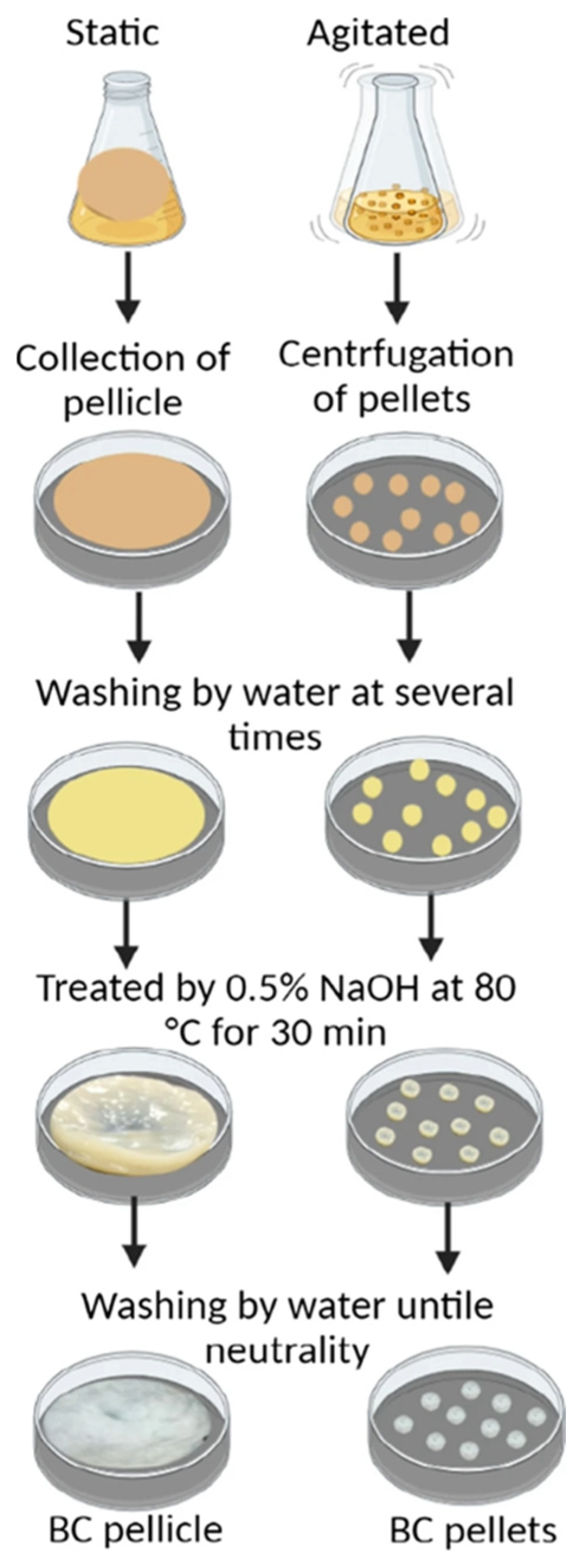
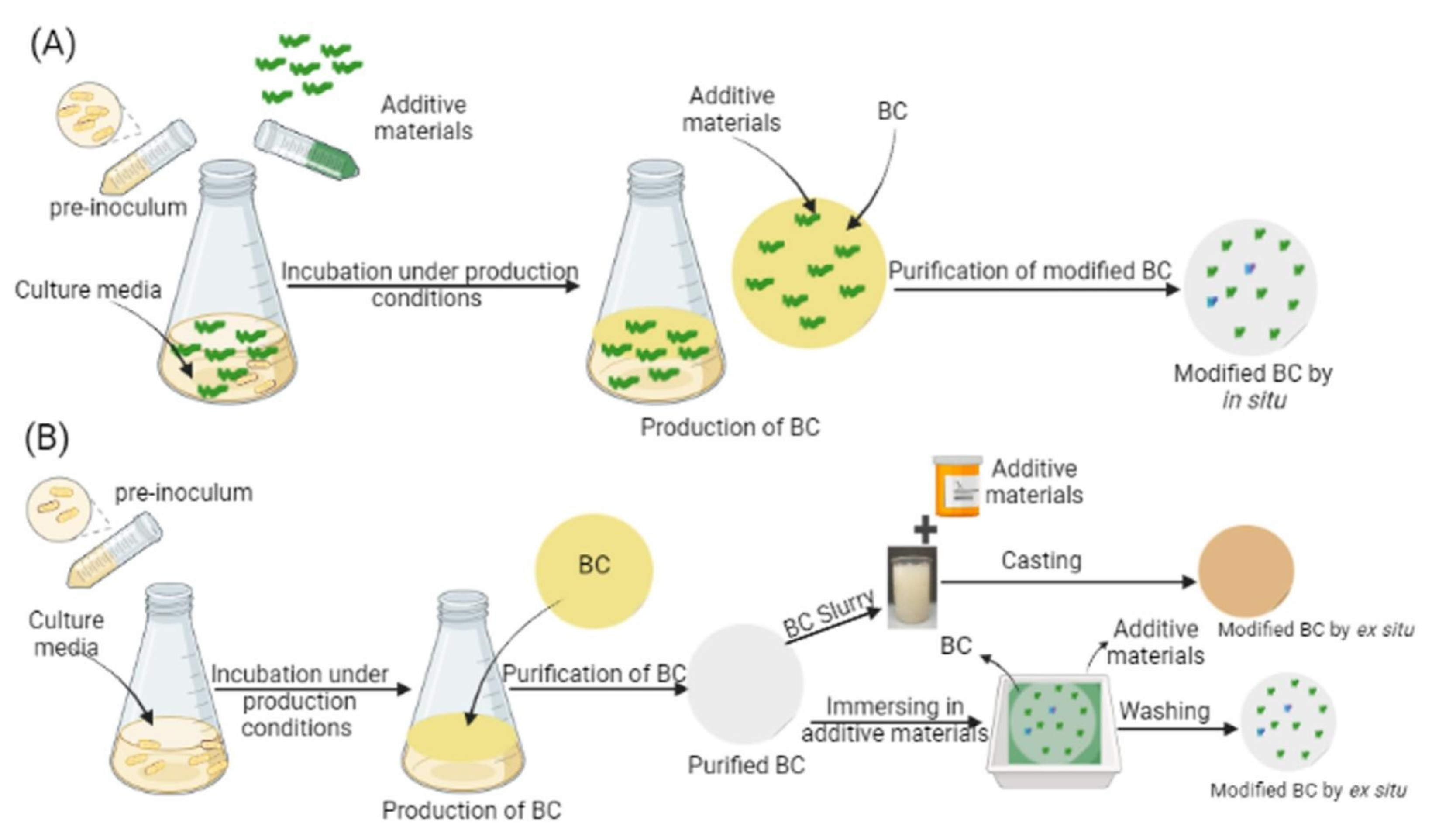
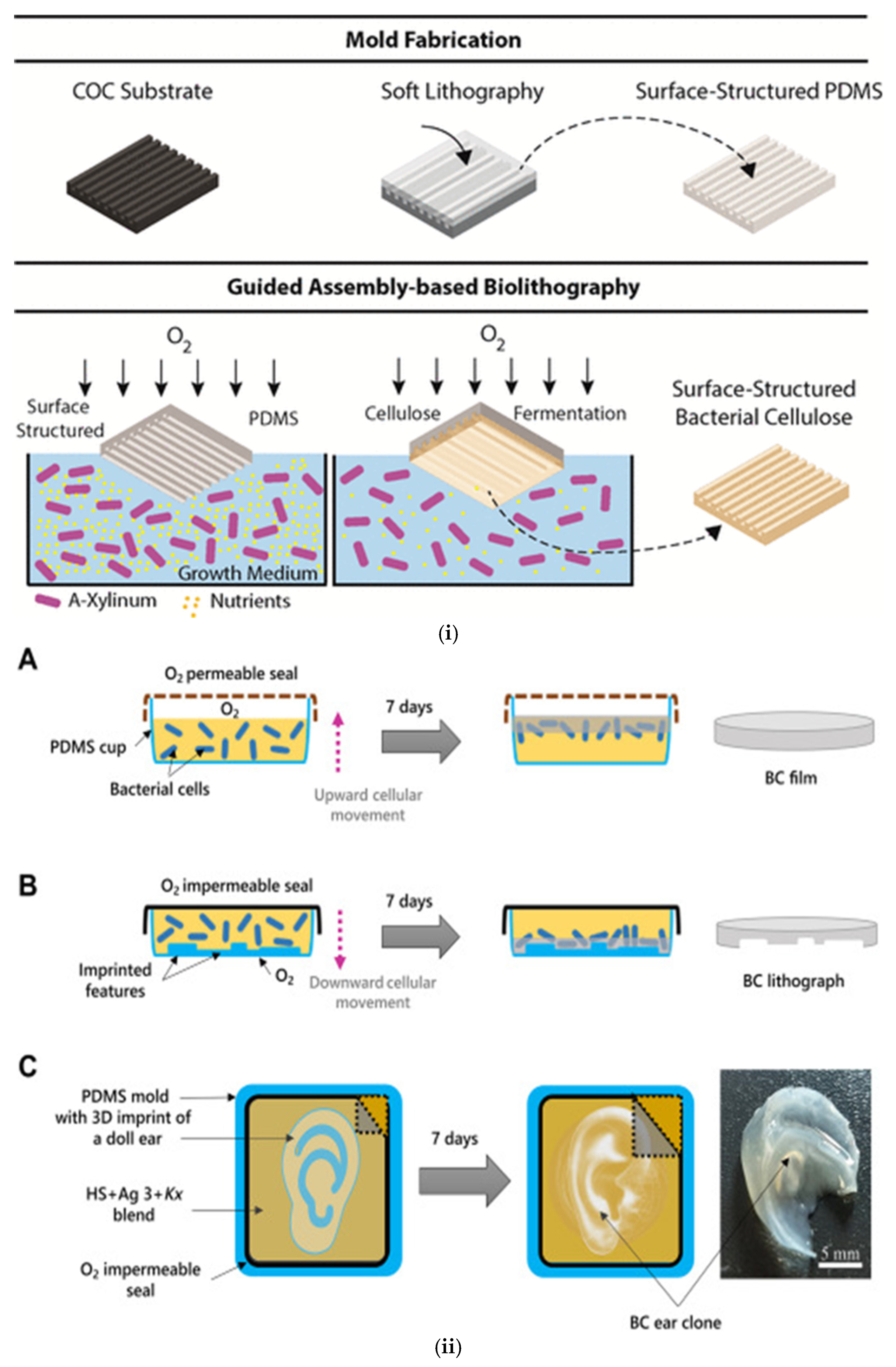
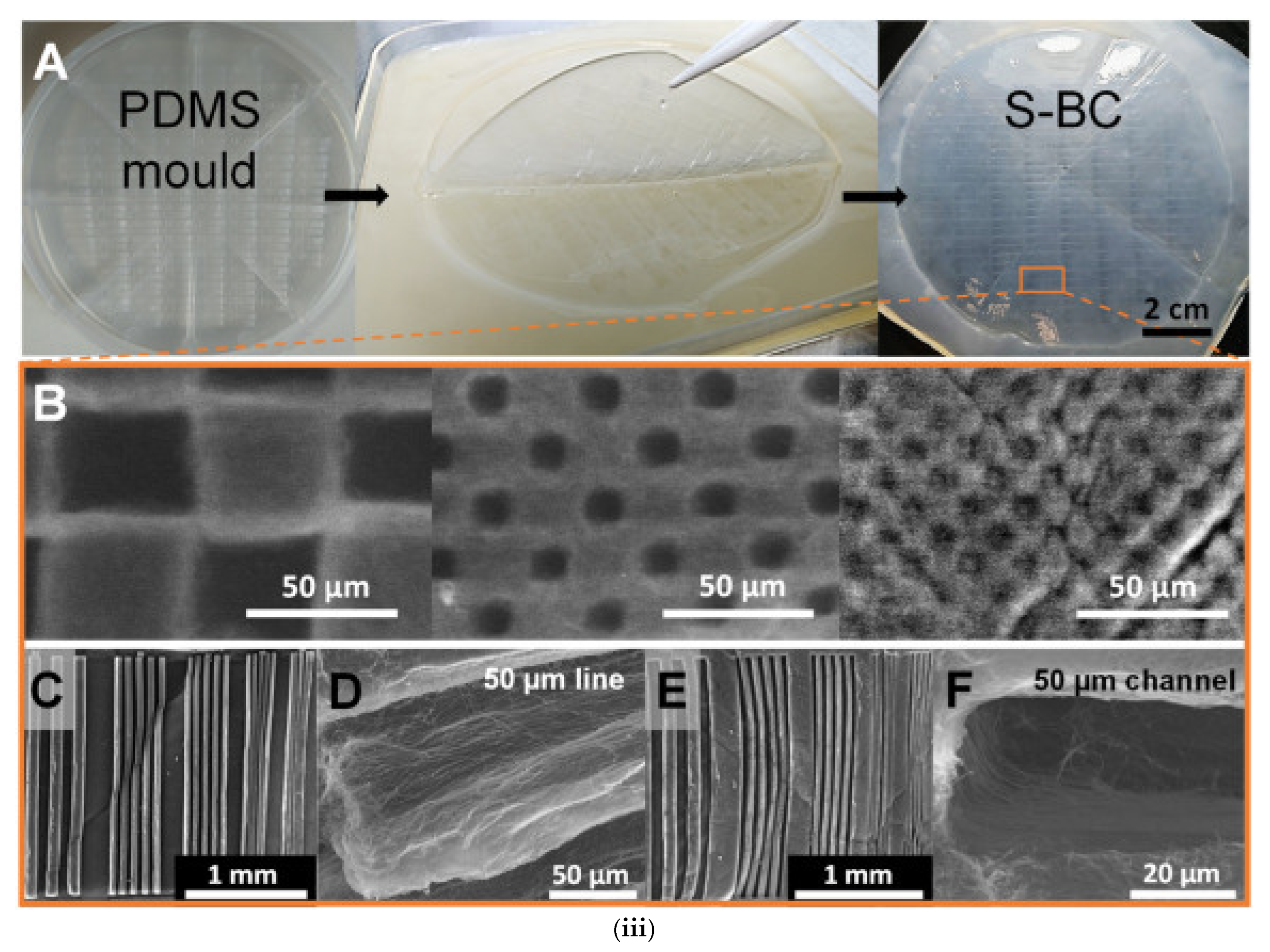
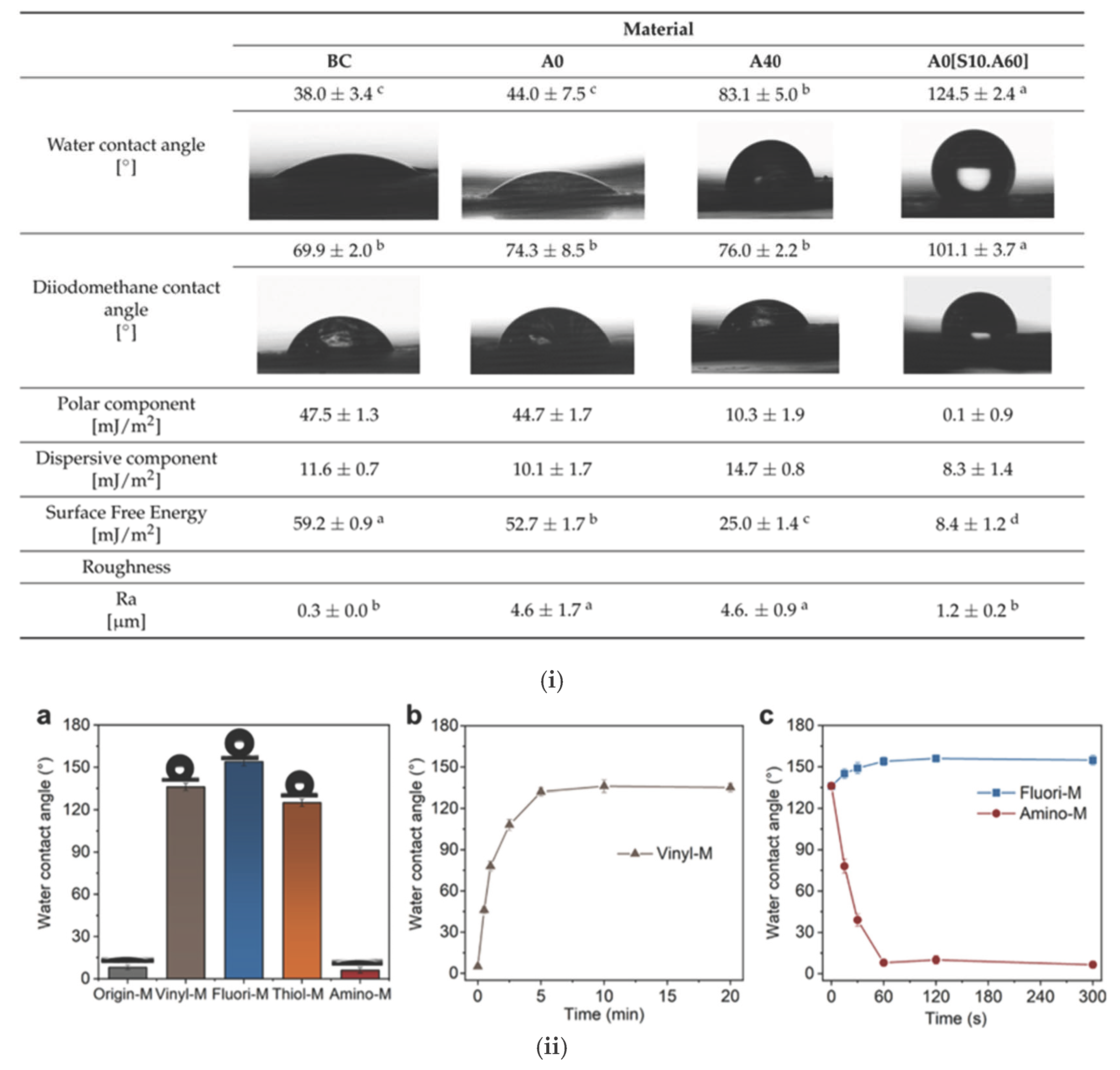
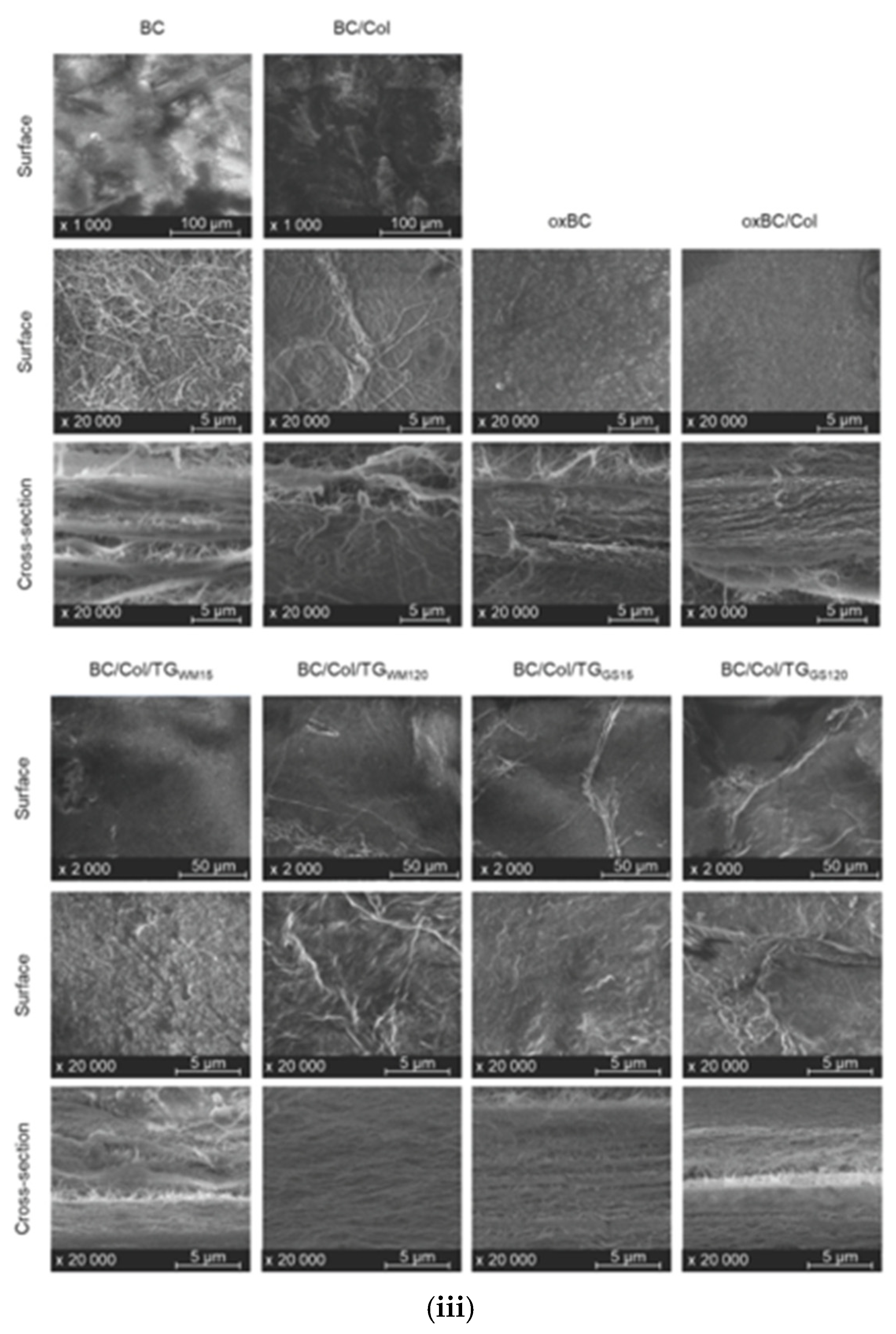
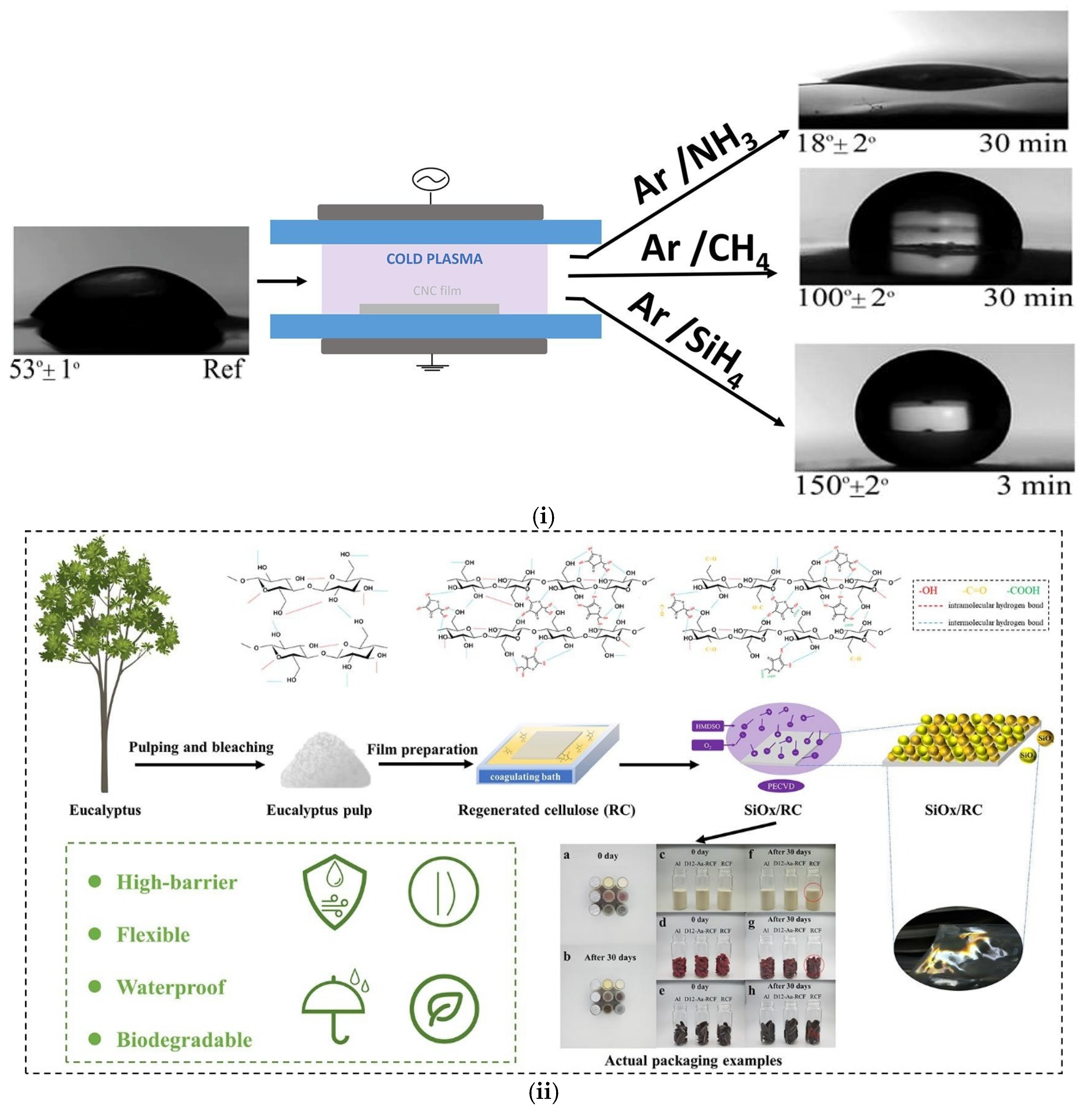
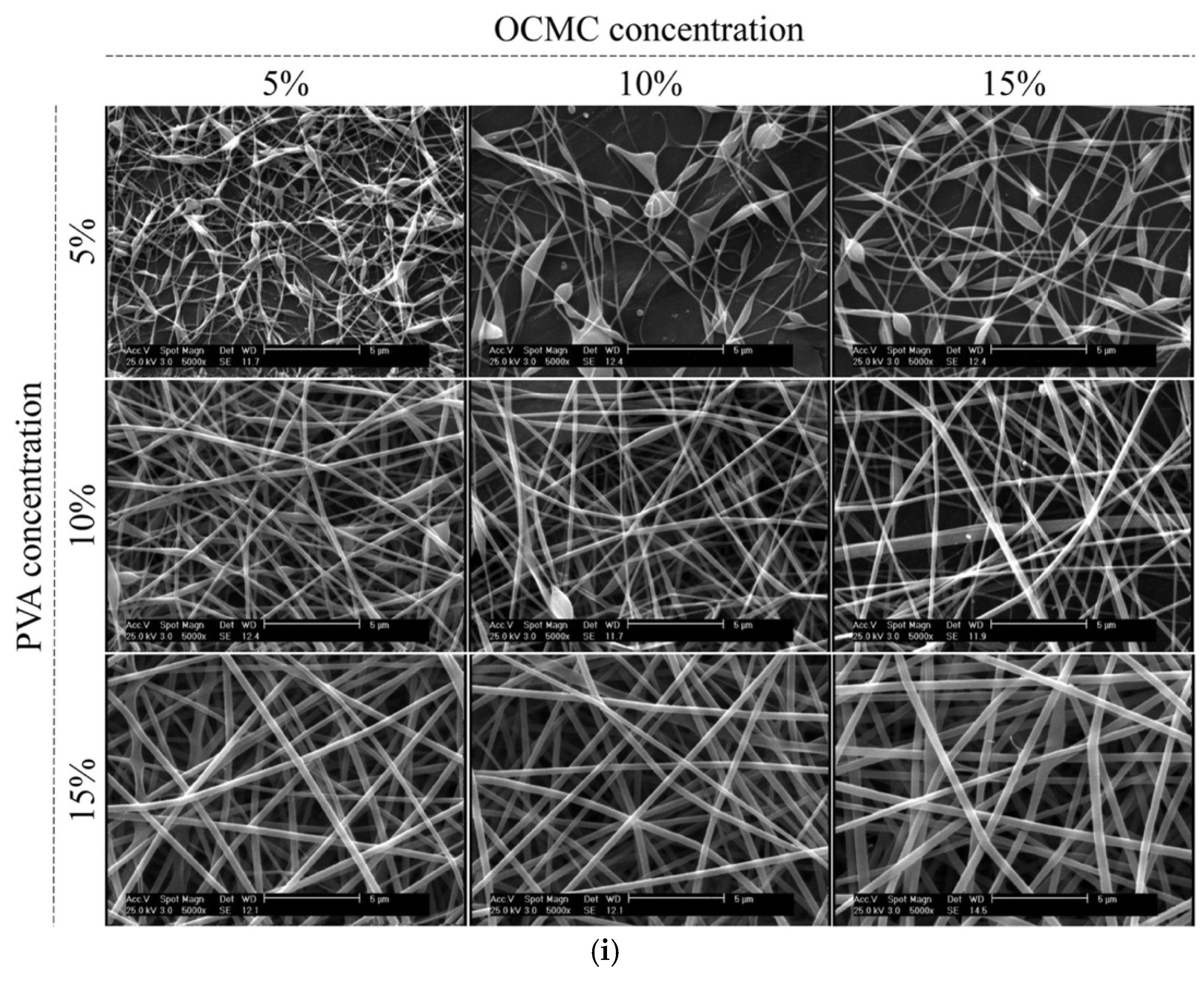
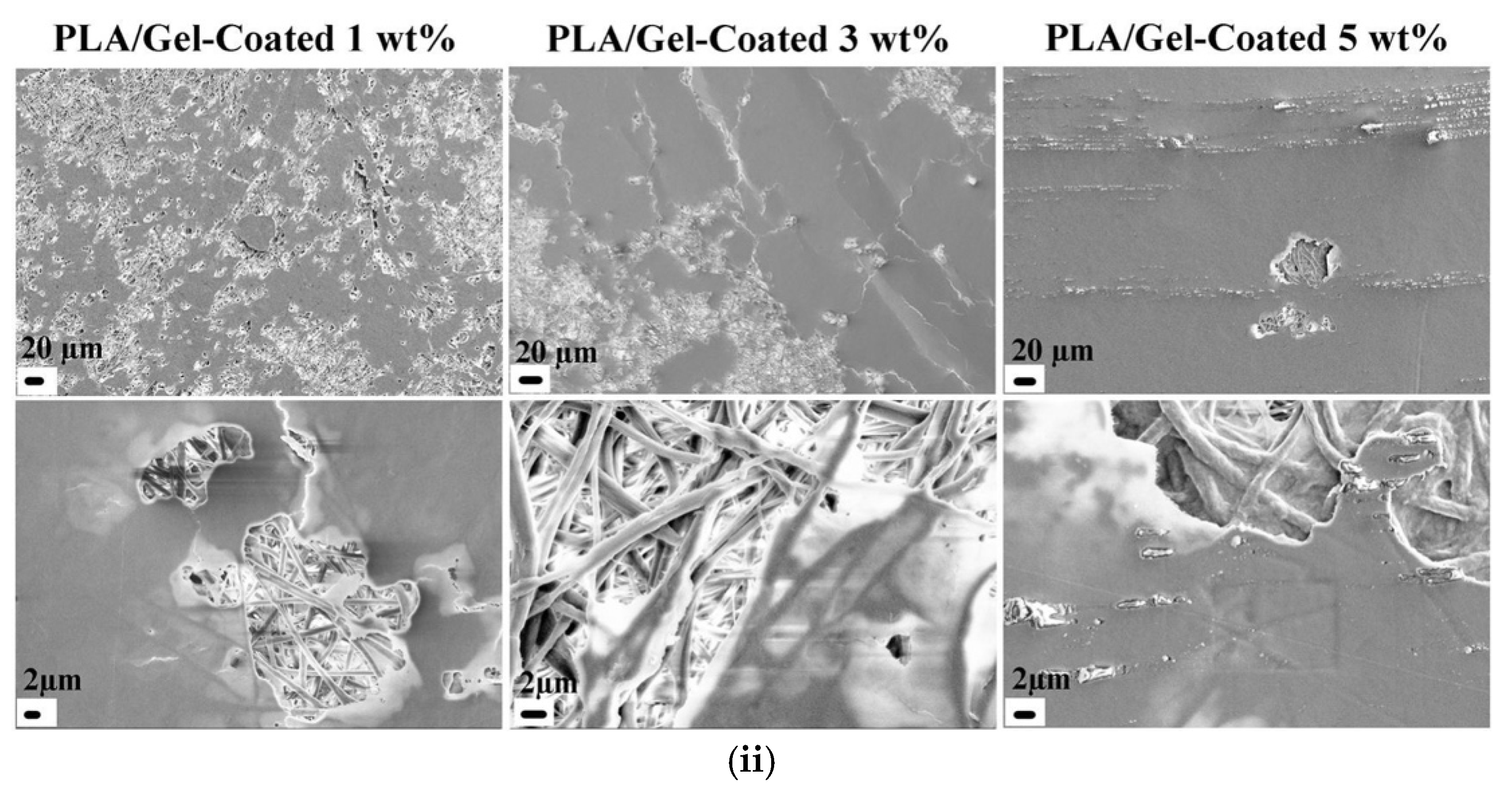
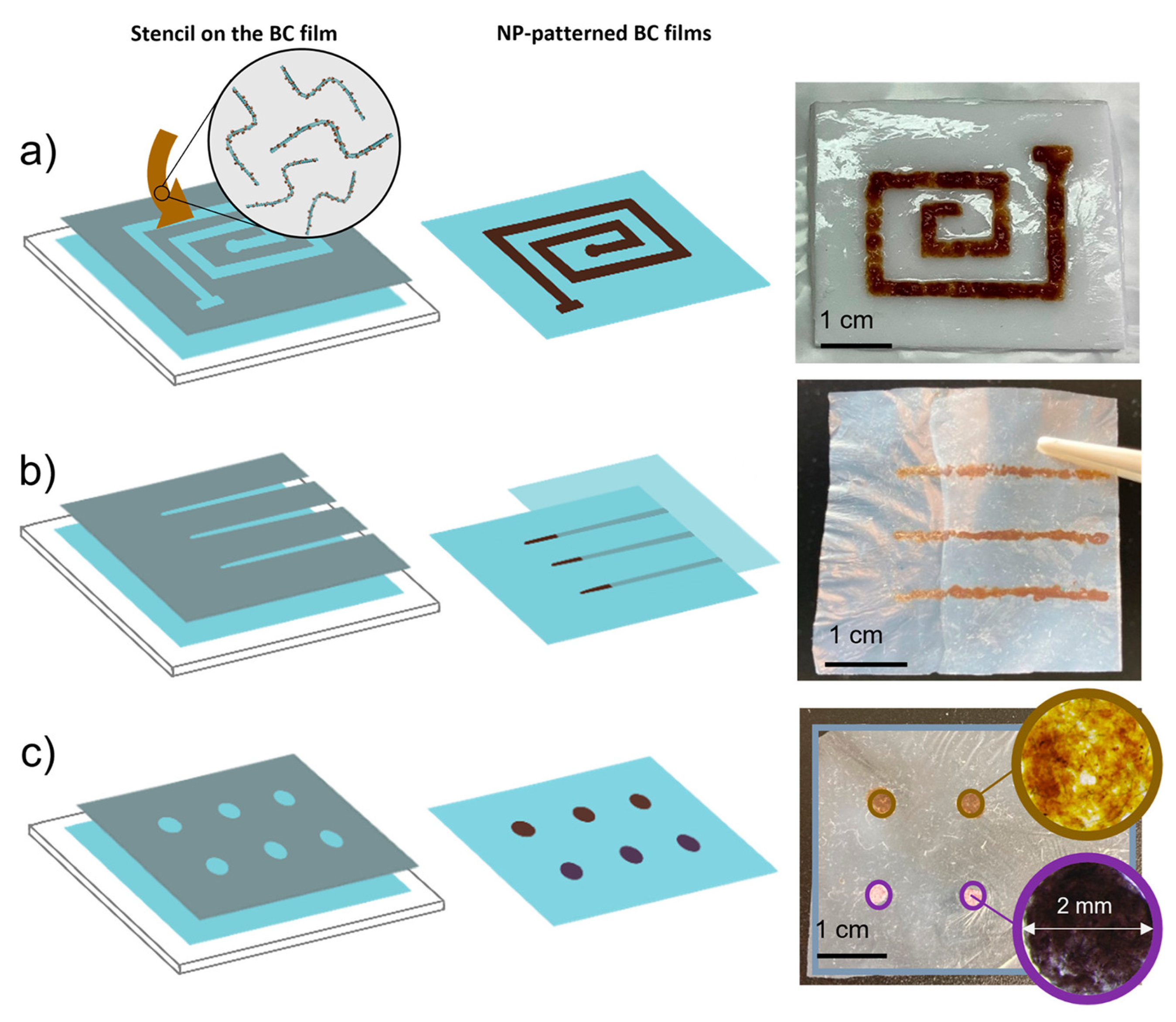
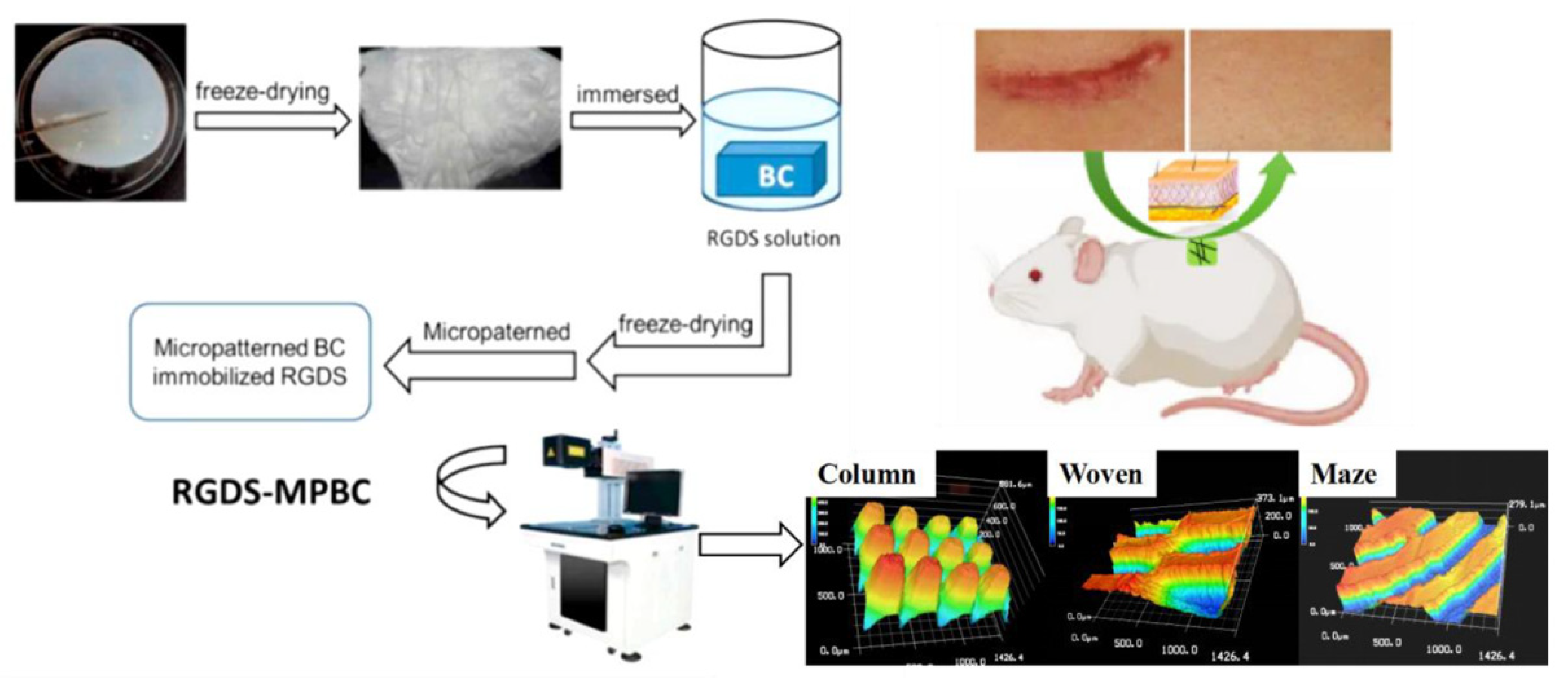

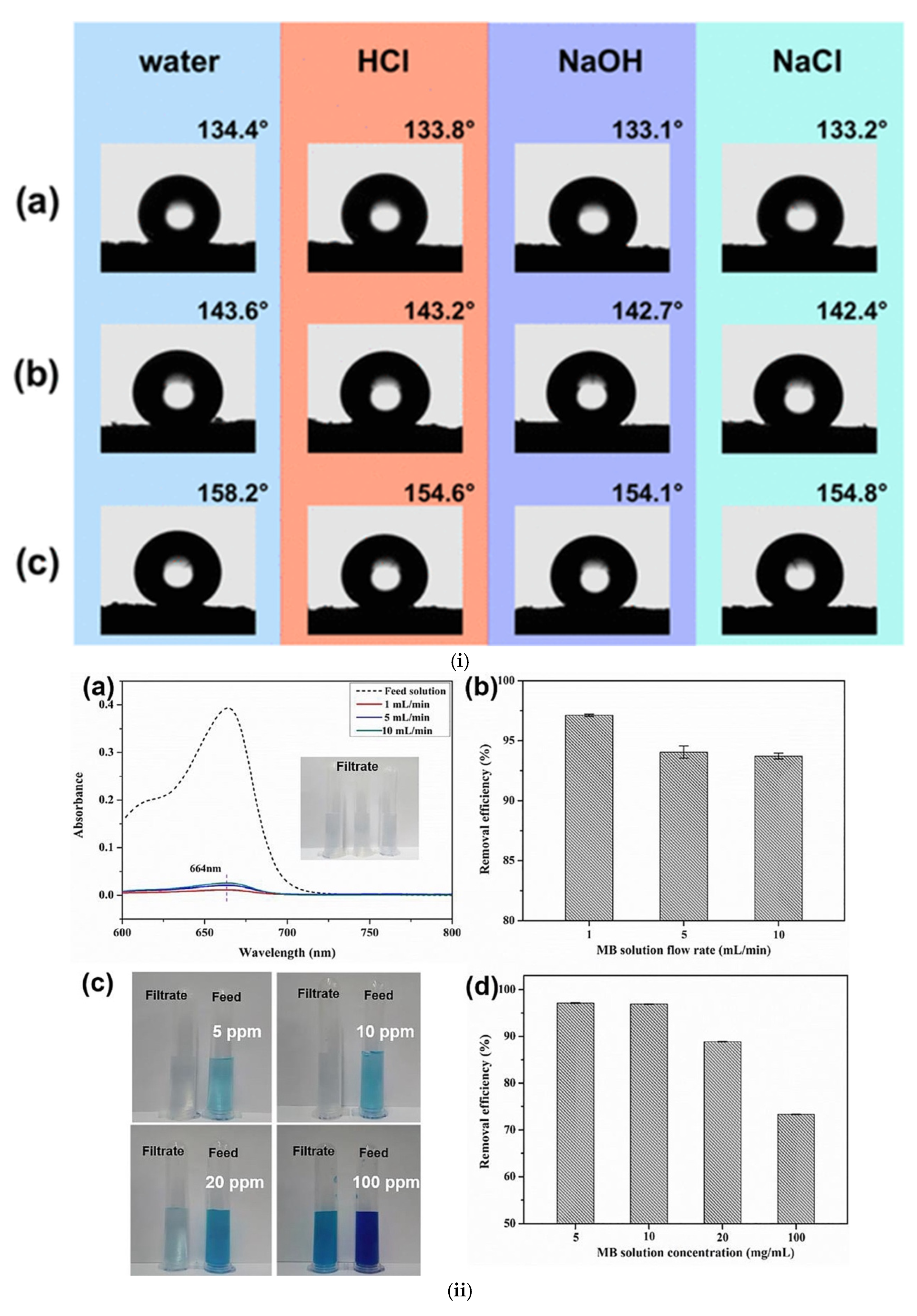
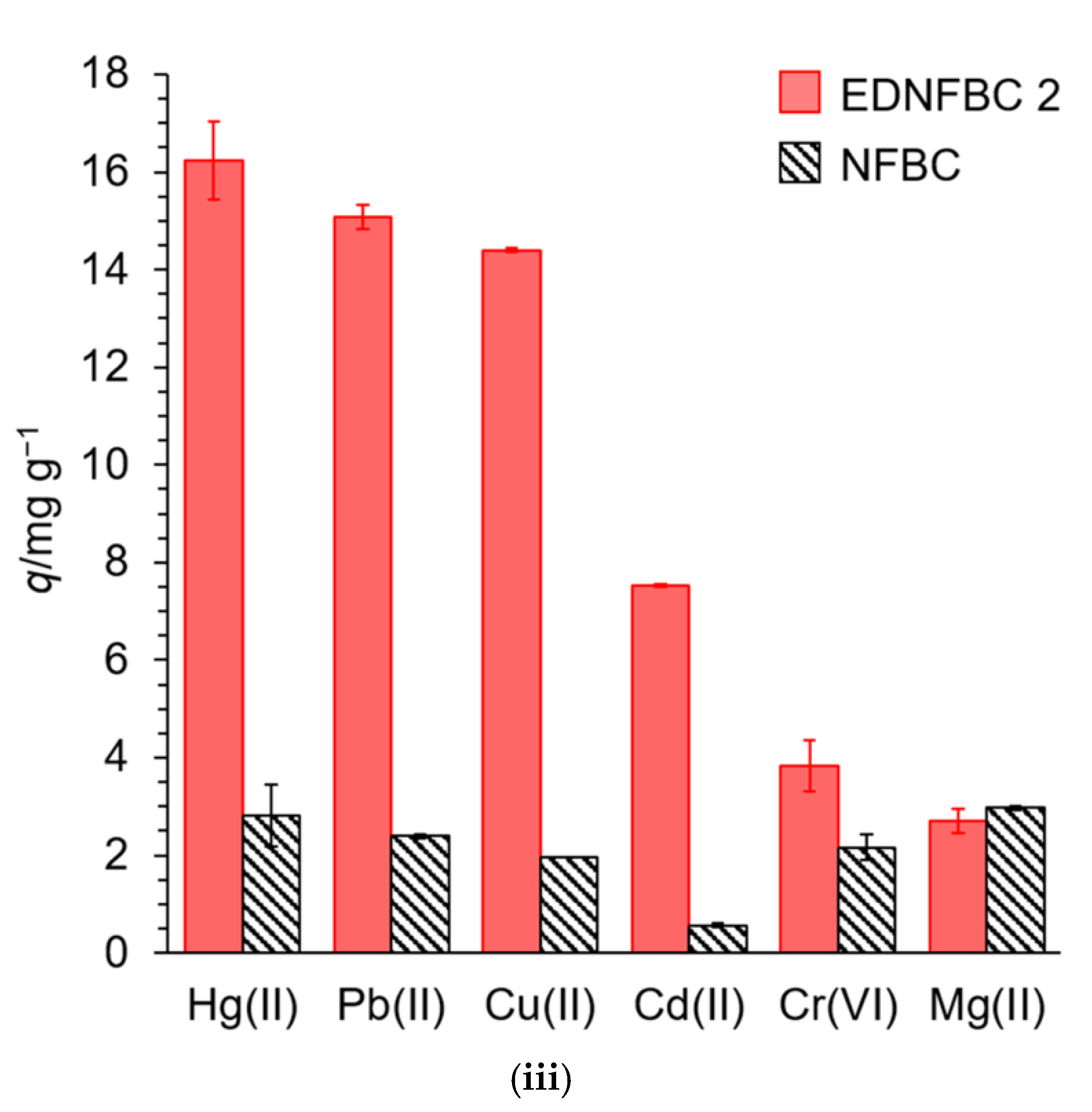
| Plant Cellulose | Bacterial Cellulose | |
|---|---|---|
| Source/Production | Derived from plants like wood, cotton, and agricultural biomass | Synthesized by bacteria such as Komagataeibacter xylinus during fermentation |
| Purity | Contains impurities like lignin and hemicellulose, requiring extensive chemical purification | Naturally produced in pure form, free of lignin and hemicellulose |
| Crystallinity/Structure | Lower crystallinity: fibrils bundled into larger fibers | High crystallinity: nanoscale fibrils form a 3D porous network |
| Water-Holding Capacity | Holds about 60% of its weight in water | Holds up to 1000% of its dry weight in water due to its unique structure |
| Applications | Paper, textiles, biofuels, cellulose derivatives (e.g., acetate, carboxymethyl cellulose) | Advanced applications: wound dressings, tissue scaffolds, drug delivery, biodegradable packaging, electronics |
| Environmental Impact | Large scale production may lead to deforestation and chemical pollution | Sustainable production using renewable/waste feedstocks, eco-friendly fermentation process |
| Cost | More economical and widely available due to abundant plant biomass | Higher production costs, which can be improved by waste feedstock utilization and new production methods |
| Reference | Year | Material | Method | Functionality Incorporated/ Property Improved | Industrial Scalability (Low/ Medium/ High) | Cost (Low/ Medium/ High) | Environmental Footprint (Low/ Medium/ High) | Applications |
|---|---|---|---|---|---|---|---|---|
| In situ wet methods | ||||||||
| [65] | 2023 | Bacterial cellulose | In situ modification (strain + carbon source + ethanol) |
| High | Low | Medium-High |
|
| [66] | 2024 | SCOBY bacterial cellulose | In situ embedding of diatoms, AgNPs, PEDOT:PSS |
| High | Low | High |
|
| [67] | 2024 | Bacterial cellulose | In situ with hairy nanocellulose (ENCC, BNCC, SNCC) |
| Medium-High | Medium | Low-Medium |
|
| [69] | 2025 | Bacterial cellulose | In situ carbonization (siloxane + polyimide, honeycomb structure) |
| Medium | Medium-High | Low- Medium |
|
| [70] | 2024 | Foamed BC | In situ with chitosan |
| Medium | Medium | Medium |
|
| [72] | 2024 | Beeswax and bacterial cellulose nanofibrils functionalized with SiO2 | Silanization of BC with food-grade SiO2 nanoparticles and incorporation into beeswax coating |
| Medium | Low-Medium | Medium |
|
| In situ biolithography methods | ||||||||
| [75] | 2024 | Bacterial cellulose | In situ 3D molding (agarose/PDMS molds) |
| Medium | Medium | Low |
|
| [76] | 2021 | Bacterial cellulose | Bio-lithography and soft imprinting with PDMS (5–200 μm) |
| Medium | Medium | Low |
|
| [73] | 2024 | Photochromic Bacterial Cellulose (PBC) | In situ fermentation |
| Medium | Medium | Low-Medium |
|
| Ex situ chemical modification methods | ||||||||
| [77] | 2024 | SCOBY BC | Glycerol, apple powder and stearic acid |
| Medium | Low | Medium-High |
|
| [78] | 2024 | Cellulose membranes | Thiol–ene click functionalization |
| Medium | Medium | Medium-High |
|
| [79] | 2021 | BC + collagen | Crosslinking (enzymatic and chemical) |
| Medium | Medium | Medium-High |
|
| [106] | 2023 | SiO2-decorated bacterial cellulose (“meta-skin”) | Ethanol-assisted SiO2 nanoparticle incorporation |
| Medium | Medium | Medium-High |
|
| [107] | 2023 | Bacterial cellulose (BC) from nata de coco modified with SiO2 nanoparticles | Hydrolysis/condensation of TEOS in ethanol/ammonia followed by coating and drying |
| Medium | Medium | Medium-High |
|
| [108] | 2023 | CNC films modified with silanes (GPMDES, GPTES, TEOS) | Spin-coating of silane–CNC mixtures, surface curing |
| Medium | Medium | Medium-High |
|
| [129] | 2021 | BC blended with needle-leaf bleached kraft pulp (NBKP) | BC/NBKP modified with copper hydroxide nanoparticles and then coated with stearic acid |
| Medium | Medium | Medium-High |
|
| [130] | 2018 | Aerogel made from bacterial cellulose (BC) and silica | BC soaked in a silica-based solution resulting in a light, solid aerogel with a stable porous structure |
| Medium | Medium | Medium-High |
|
| Plasma based methods | ||||||||
| [88] | 2024 | Bacterial cellulose | Cathodic cage plasma (Ar/C2H2, 30 min) |
| Medium | Medium-High | Low |
|
| [89] | 2022 | BC + Ag NPs | Plasma + magnetron sputtering |
| Low | Medium-High | Low |
|
| [92] | 2020 | Bacterial cellulose | O2 plasma + TCMS silanization (CVD) |
| Low | Medium-High | Low |
|
| [94] | 2020 | CNC films | DBD plasma (Ar/CH4, Ar/NH3, Ar/SiH4) |
| Medium | Medium-High | Low |
|
| [95] | 2025 | Regenerated cellulose | Ascorbic acid + PECVD (SiOx) |
| Low | Medium-High | Low |
|
| [96] | 2023 | Fibrillated cellulose | HMDSO plasma (30 min) + 5% CMC bilayer |
| Low | Medium-High | Low |
|
| Electrospinning | ||||||||
| [101] | 2025 | OCMC/PVA Gelatin nanofibers | Dual eletrospinning + in situ Schiff-base crosslinking |
| Low | Medium | Medium |
|
| [102] | 2025 | PLA/Gel + QACNC | QACNC (DTSACl-CNC) blended/coated on nanofibers |
| Low | Medium | Low |
|
| [103] | 2020 | PLA/CNCs | Electrospun PLA + rice husk CNCs |
| Low | Medium | Low |
|
| Laser Patterning | ||||||||
| [112] | 2019 | Bacterial cellulose with RGDS peptide (RGDS-MPBC) | CO2 laser photolithography and targeted RGDS immobilization |
| Low | High | Low |
|
| Ex situ imprinting methods | ||||||||
| [114] | 2018 | Hydroxypropyl Cellulose (HPC) | Soft Nanoimprinting Lithography |
| Medium | Medium | Low |
|
| [115] | 2018 | Cellulose nanocrystals (CNCs) | Solvent-assisted soft nanoimprint lithography(SA-SNIL) |
| Low-Medium | Medium | Low |
|
Disclaimer/Publisher’s Note: The statements, opinions and data contained in all publications are solely those of the individual author(s) and contributor(s) and not of MDPI and/or the editor(s). MDPI and/or the editor(s) disclaim responsibility for any injury to people or property resulting from any ideas, methods, instructions or products referred to in the content. |
© 2025 by the authors. Licensee MDPI, Basel, Switzerland. This article is an open access article distributed under the terms and conditions of the Creative Commons Attribution (CC BY) license (https://creativecommons.org/licenses/by/4.0/).
Share and Cite
Ntovolou, I.; Farkatsi, D.; Ellinas, K. The Quest Towards Superhydrophobic Cellulose and Bacterial Cellulose Membranes and Their Perspective Applications. Micro 2025, 5, 37. https://doi.org/10.3390/micro5030037
Ntovolou I, Farkatsi D, Ellinas K. The Quest Towards Superhydrophobic Cellulose and Bacterial Cellulose Membranes and Their Perspective Applications. Micro. 2025; 5(3):37. https://doi.org/10.3390/micro5030037
Chicago/Turabian StyleNtovolou, Iliana, Despoina Farkatsi, and Kosmas Ellinas. 2025. "The Quest Towards Superhydrophobic Cellulose and Bacterial Cellulose Membranes and Their Perspective Applications" Micro 5, no. 3: 37. https://doi.org/10.3390/micro5030037
APA StyleNtovolou, I., Farkatsi, D., & Ellinas, K. (2025). The Quest Towards Superhydrophobic Cellulose and Bacterial Cellulose Membranes and Their Perspective Applications. Micro, 5(3), 37. https://doi.org/10.3390/micro5030037







